Early Views of Pasadena
Historical Photos of Early Pasadena |
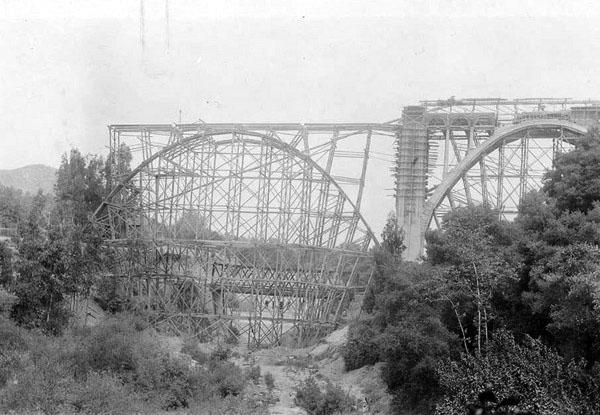 |
|
| (1913)*#* - View showing the Colorado Street Bridge under construction. You can just make out another bridge in the background. It is the 1887-built Scoville Bridge. |
Historical Notes Construction began in July 1912 and lasted 18 months, employing 40 to 100 workers on any given day. Built with 11,000 cubic yards of concrete -- made from gravel collected from the arroyo -- and 600 tons of steel reinforcement, the bridge cost a total of $235,000.*#* |
.jpg) |
|
| (1913)* - Group photo near the base of the Colorado Street Bridge under construction. Photo from Kyle Shiroma personal collection. |
 |
|
| (1913)++# - View looking west showing the Colorado Street Bridge under construction. The old Scoville Bridge is seen at center-right. |
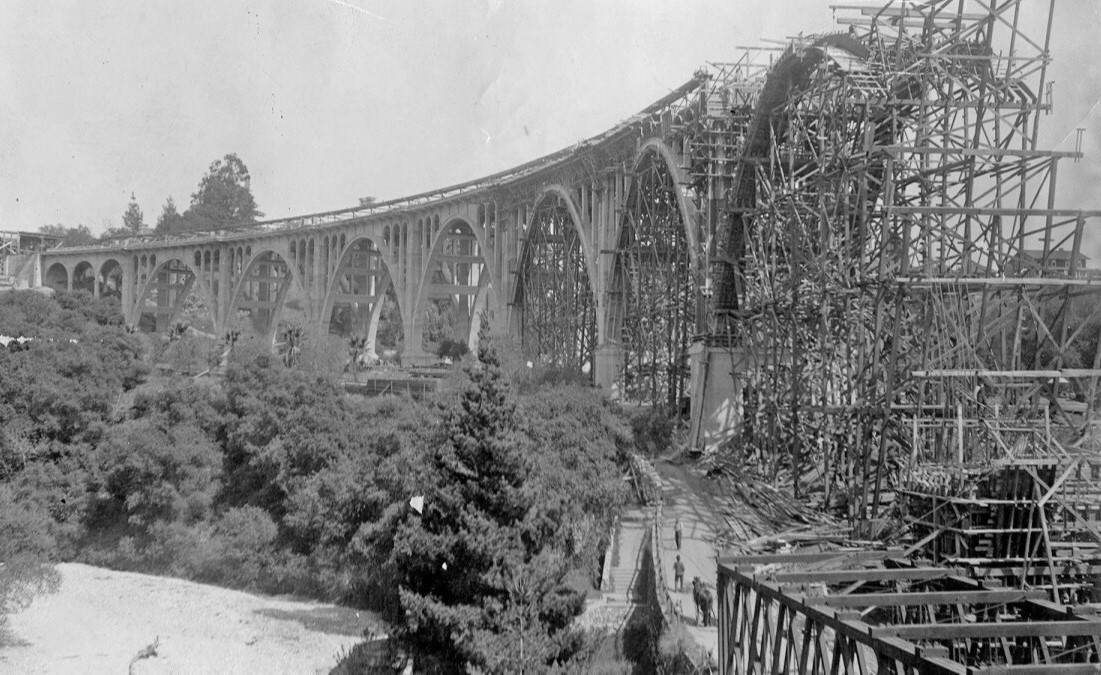 |
|
| (1913)* - Colorado Street Bridge under construction with the old Scoville Bridge seen at lower-right. |
Historical Notes The bridge was completed in December 1913 at a cost of $240,000. The 1,467.5-foot span over the Arroyo Seco chasm that separates Pasadena from Eagle Rock. |
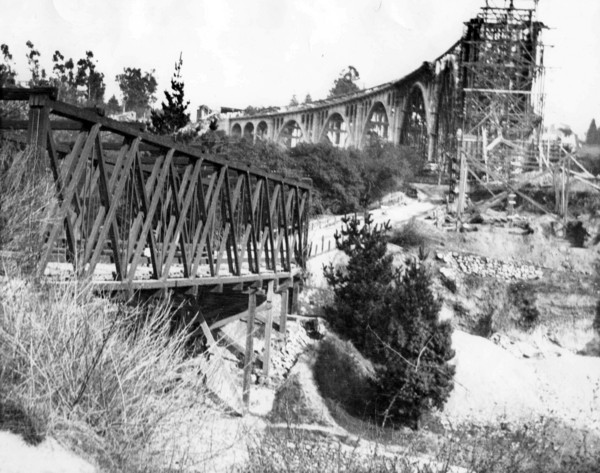 |
|
| (ca. 1913)*#* - View showing a partially completed Colorado Street Bridge with the Scoville Bridge in the foreground. |
Historical Notes The Scoville Bridge survived until the flood of 1914, when the trestle was carried all the way down the Arroyo Seco and into the Los Angeles River. |
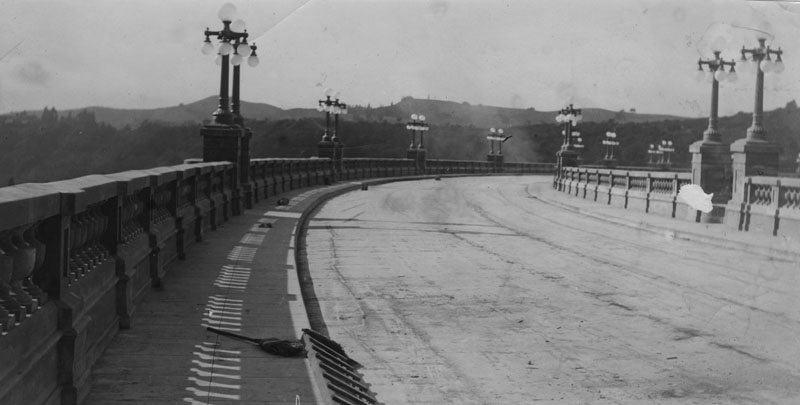 |
|
| (1913)* - View looking west of the Colorado Street Bridge before it officially opened. Ornate 5-lamp streetlights line both sides of the bridge. |
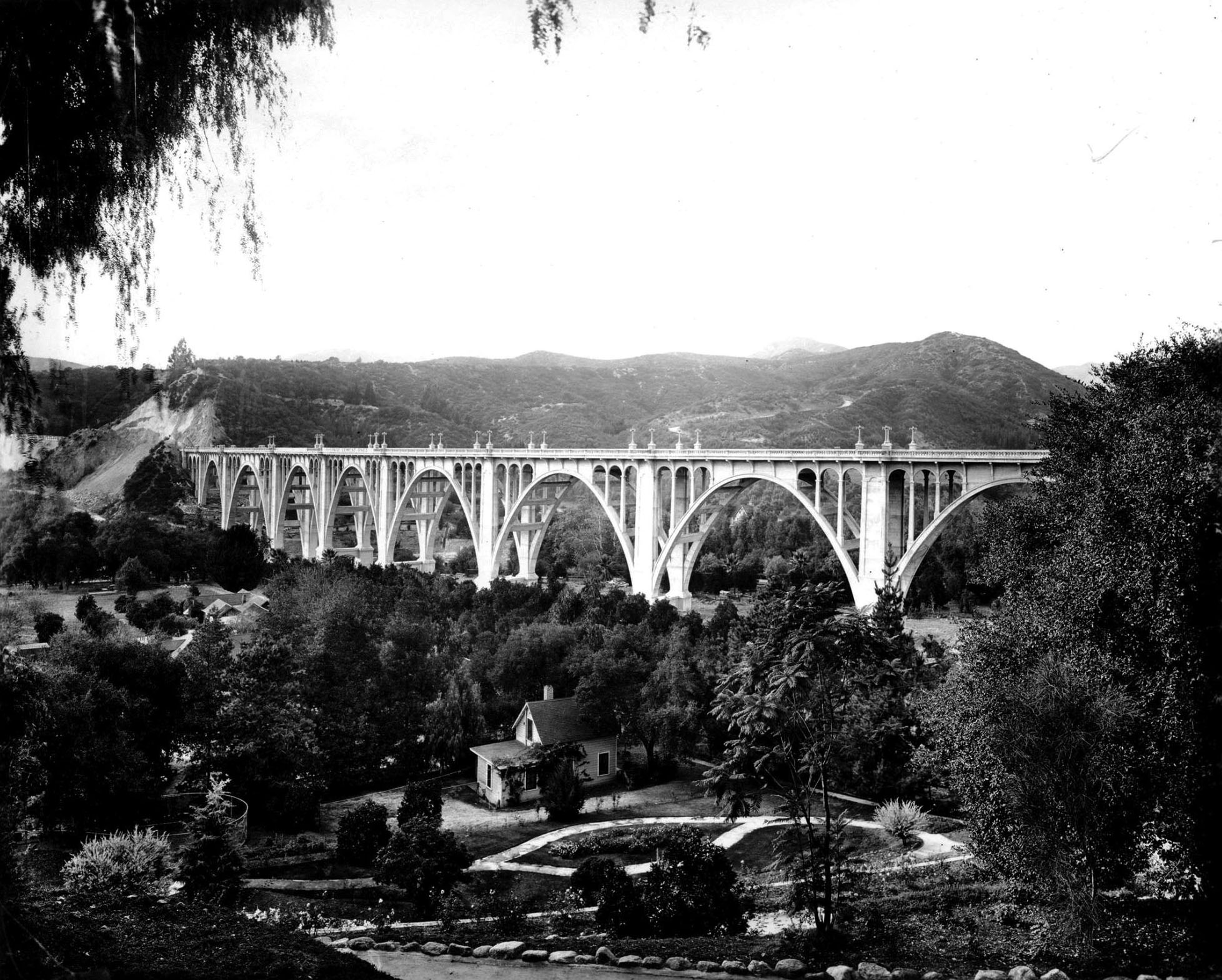 |
|
| (1913)++# - View of the Colorado Street Bridge, looking northwest. The trusted deck arch bridge appears to be in the late stage of its construction. At the left end of the bridge are construction machinery with the undeveloped part of the mountain blocking the road and the bridge from connecting. Nearby the bridge are several residential houses with a two-story house is clearly visible in the foreground. |
Historical Notes With its majestic arches rising 150 feet above the deeply cut Arroyo Seco, the Colorado Street Bridge was proclaimed the highest concrete bridge in the world upon completion in 1913. The bridge impressed travelers from the day it opened. Until then, the crossing of the Arroyo Seco required horses and wagons to descend the steep eastern slope, cross a small bridge (Scoville Bridge) over the stream, and then climb the west bank through Eagle Rock Pass.**^ |
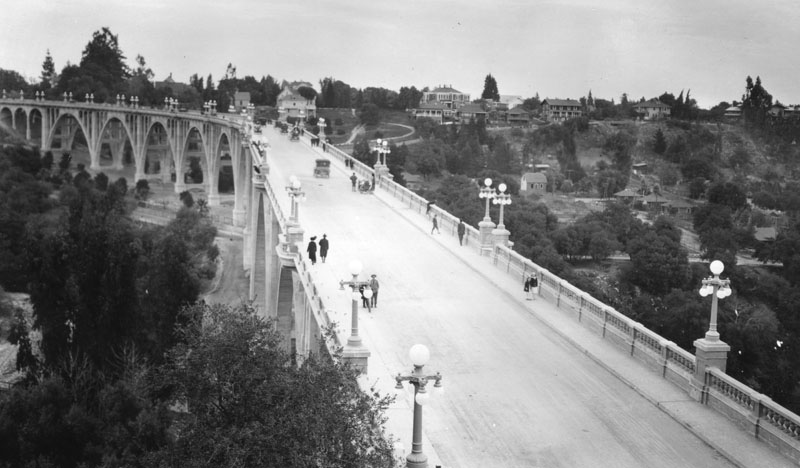 |
|
| (ca. 1913)* - View of the Colorado Street Bridge shows people walking on the bridge and enjoying the surrounding scenery. A few automobiles can be seen travelling on the bridge. |
Historical Notes The Colorado Street Bridge was designed and built by the Kansas City (MO)-based firm of J.A.L. Waddell. With a span of 1,486 feet and known for its distinctive Beaux Arts arches, lights, and railings, the bridge is on the National Register of Historic Places and has been designated a National Historic Civil Engineering Landmark by the American Society of Civil Engineers.* |
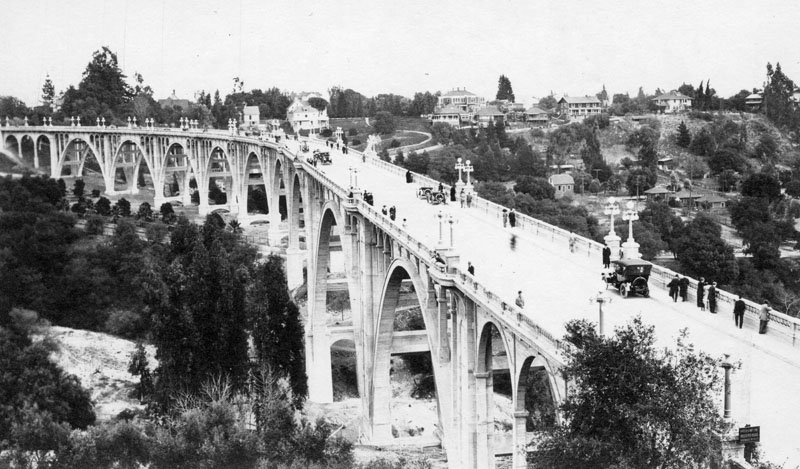 |
|
| (ca. 1913)* - Another view of the Colorado Street Bridge shows several groups of people walking on the bridge. The original La Vista del Arroyo Hotel can be seen in the background to the right of the bridge. |
Historical Notes The site's resort history dates to 1882, when Emma C. Bangs opened the original La Vista del Arroyo Hotel, a two-story, wood-frame building, and series of small cottages. In 1919, hotel tycoon Daniel M. Linnard, associated with such elegant Pasadena hotels as the Huntington and Green, purchased La Vista del Arroyo with the vision of developing the property into an opulent resort. Linnard commissioned the noted architectural firm of Marston & Van Pelt to design a large, two-story Spanish Colonial Revival hotel to replace the original structure. Once the popularity of the Vista had been established, select guests also built bungalows on the property.*^ |
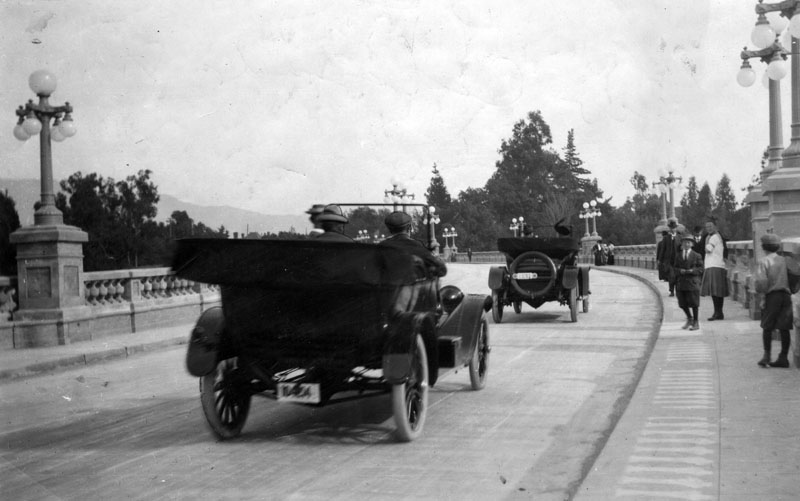 |
|
| (1913)* - Automobiles travel east on the Colorado Street Bridge, located over the Arroyo Seco in Pasadena, captured not long after it was completed. Pedestrians are seen strolling along the path on the right. |
Historical Notes Only two lanes wide, the bridge was considered inadequate as early as the 1930s. The bridge remained part of Route 66 until the 1940 completion of the Arroyo Seco Parkway. After the route moved to the Arroyo Seco Parkway, Colorado continued to be signed as Alternate 66 until 1964. |
.jpg) |
|
| (1913)* - Early model car and pedestrians try out the newly constructed Colorado Street Bridge. |
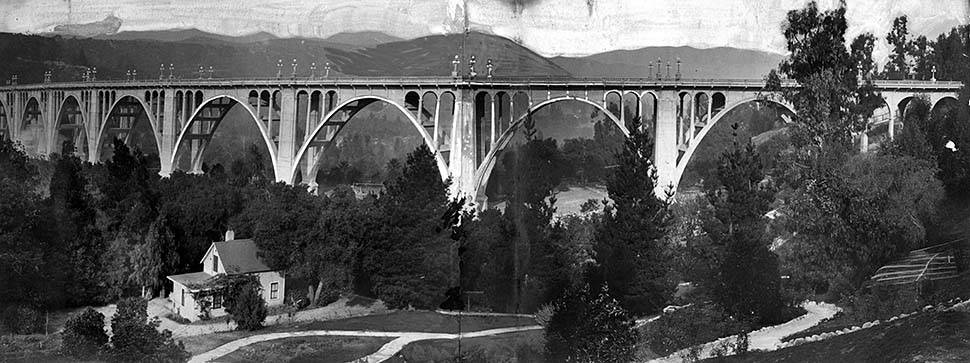 |
|
| (1914)^*# - Panorama of the new Colorado Street Bridge across the Arroyo Seco in Pasadena. This photo was published in the Dec. 14, 1914, Los Angeles Times. |
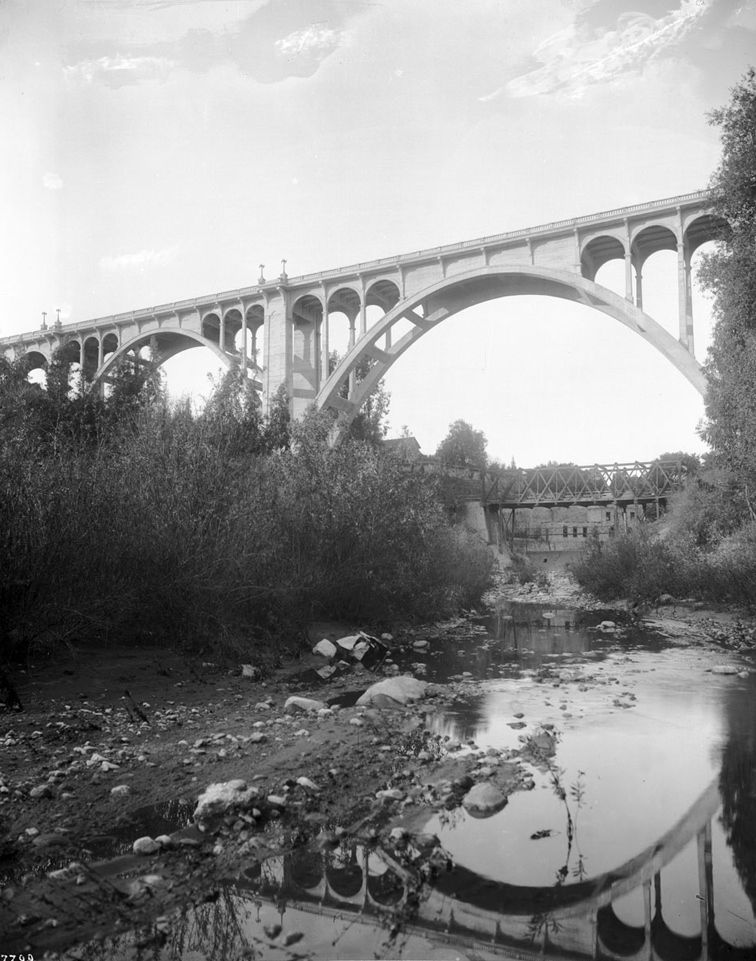 |
|
| (1914)^ - View looking up towards the Colorado Street Bridge showing its reflection in the water below. The bridge’s graceful Beaux Arts arches first crossed the Arroyo Seco in 1913. In the distance stands the Scoville Bridge in its last year. |
Historical Notes Rising 144 feet above the mostly dry ravine below, the bridge earned an unfortunate nickname — Suicide Bridge — after dozens of people leaped from the structure to their deaths during the Great Depression.^ |
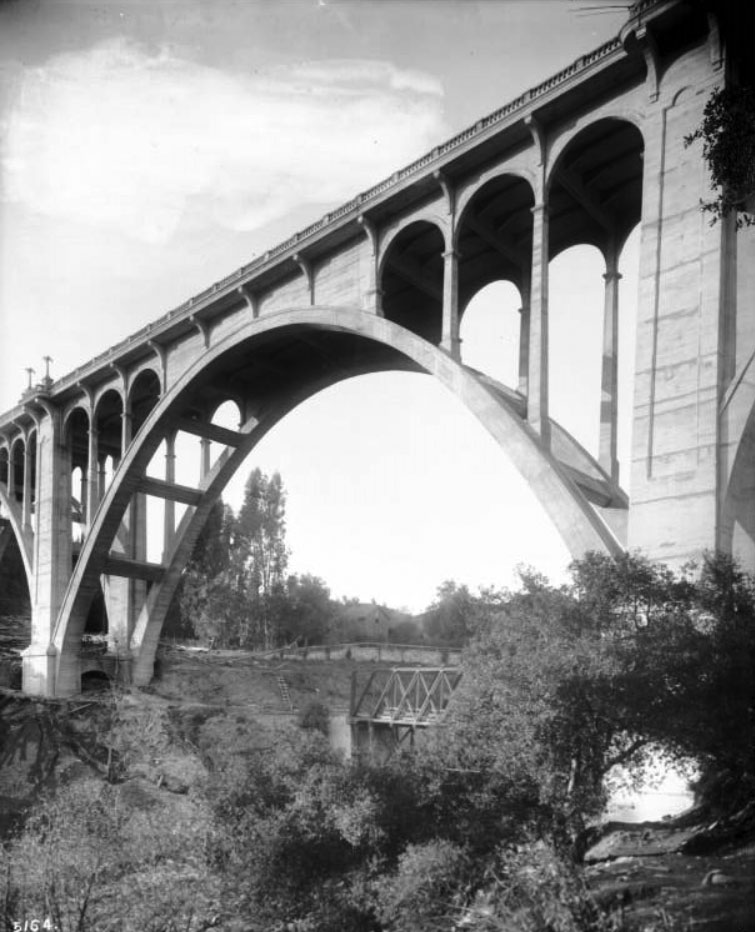 |
|
| (ca. 1914)^ - Close-up view of the Colorado Street Bridge looking up from its base with the Scoville Bridge behind it. |
Historical Notes The Scoville Bridge survived until the flood of 1914, when the trestle was carried all the way down the Arroyo Seco and into the Los Angeles River. |
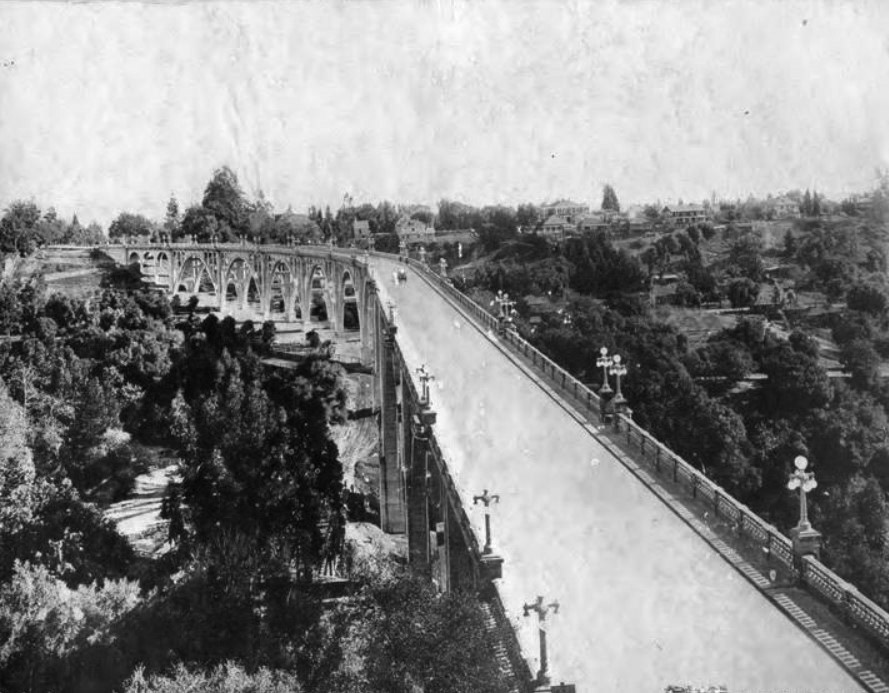 |
|
| (ca. 1915)*^* – Along the Colorado Street Bridge. |
 |
|
| (ca. 1920)* - View of the Colorado Street Bridge, also known as the Arroyo Seco Bridge, in Pasadena. The Colorado Street Bridge was designed and built in 1913. |
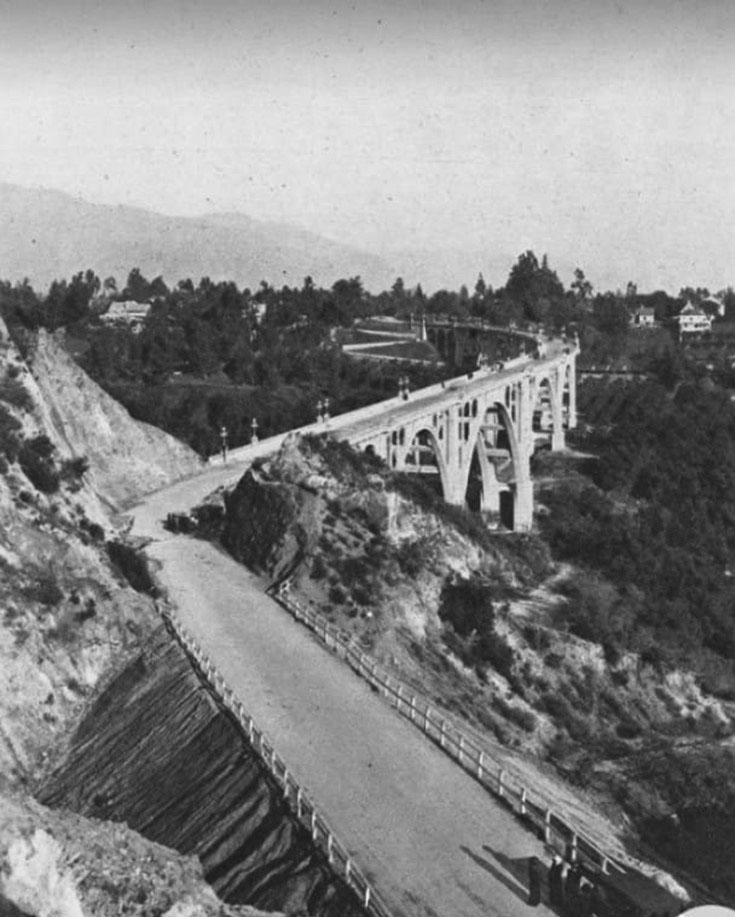 |
|
| (1910s)*- What appears to be a landslide blocks a portion of the road leading to the Colorado Street Bridge. A group of people are seen standing by their car the right foreground. Missing in this photo is the Vista del Arroyo Hotel, which was built in 1920. |
Historical Notes The Vista Del Arroyo Hotel's main building was constructed in two sections—the two-story north wing, in 1920, and the six-story bell tower with flanking wings, in 1930. |
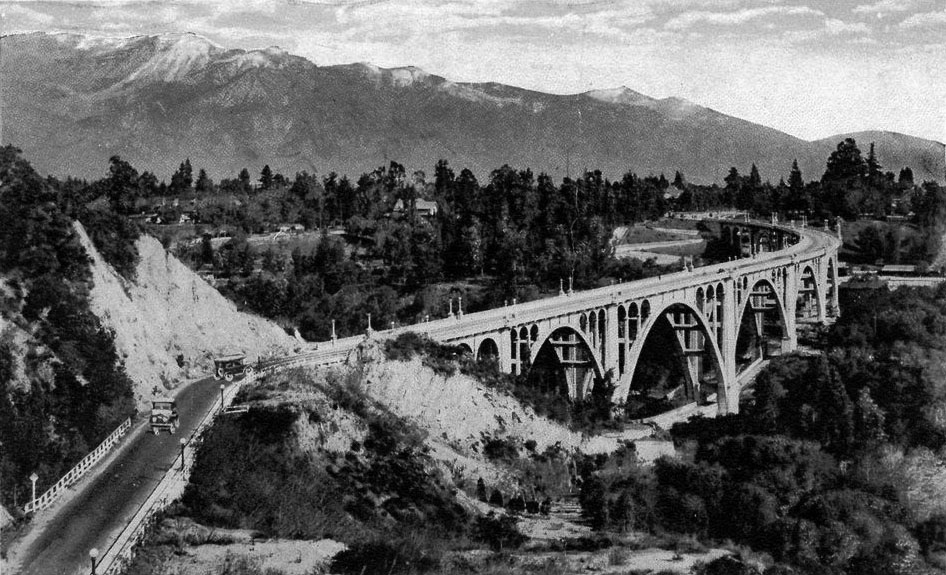 |
|
| (ca. 1920)++# - Postcard view of the Colorado Street Bridge with snow-capped San Gabriel Mountains in the background. |
 |
|
| (ca. 1920)** – Panoramic view looking east showing the Colorado Street Bridge on the right and the shorter Linda Vista Bridge on the left. They both span the Arroyo Seco. |
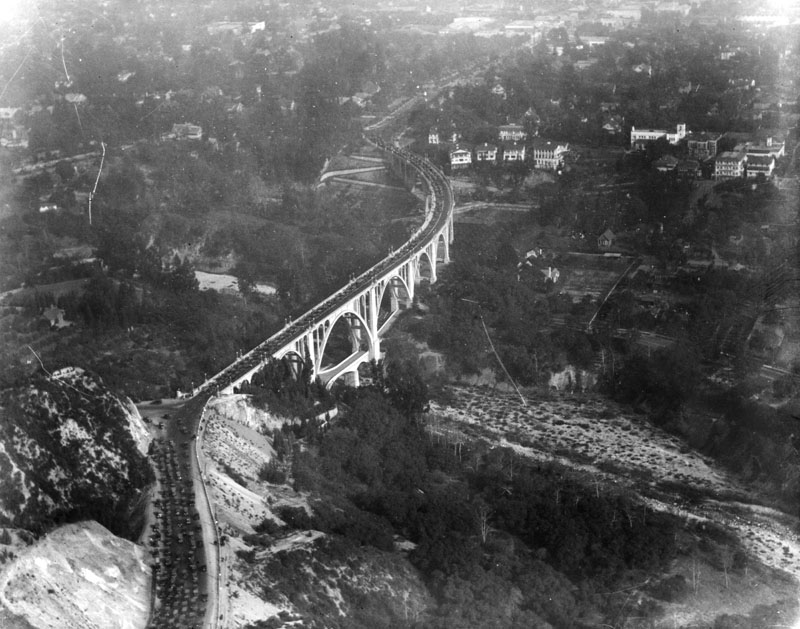 |
|
| (ca. 1920s)* - Aerial view of traffic congestion on the Colorado Street Bridge. Cars are backed up across the bridge, and further. The cars could quite possibly be heading to the first Rose Bowl game held on January 1, 1923. |
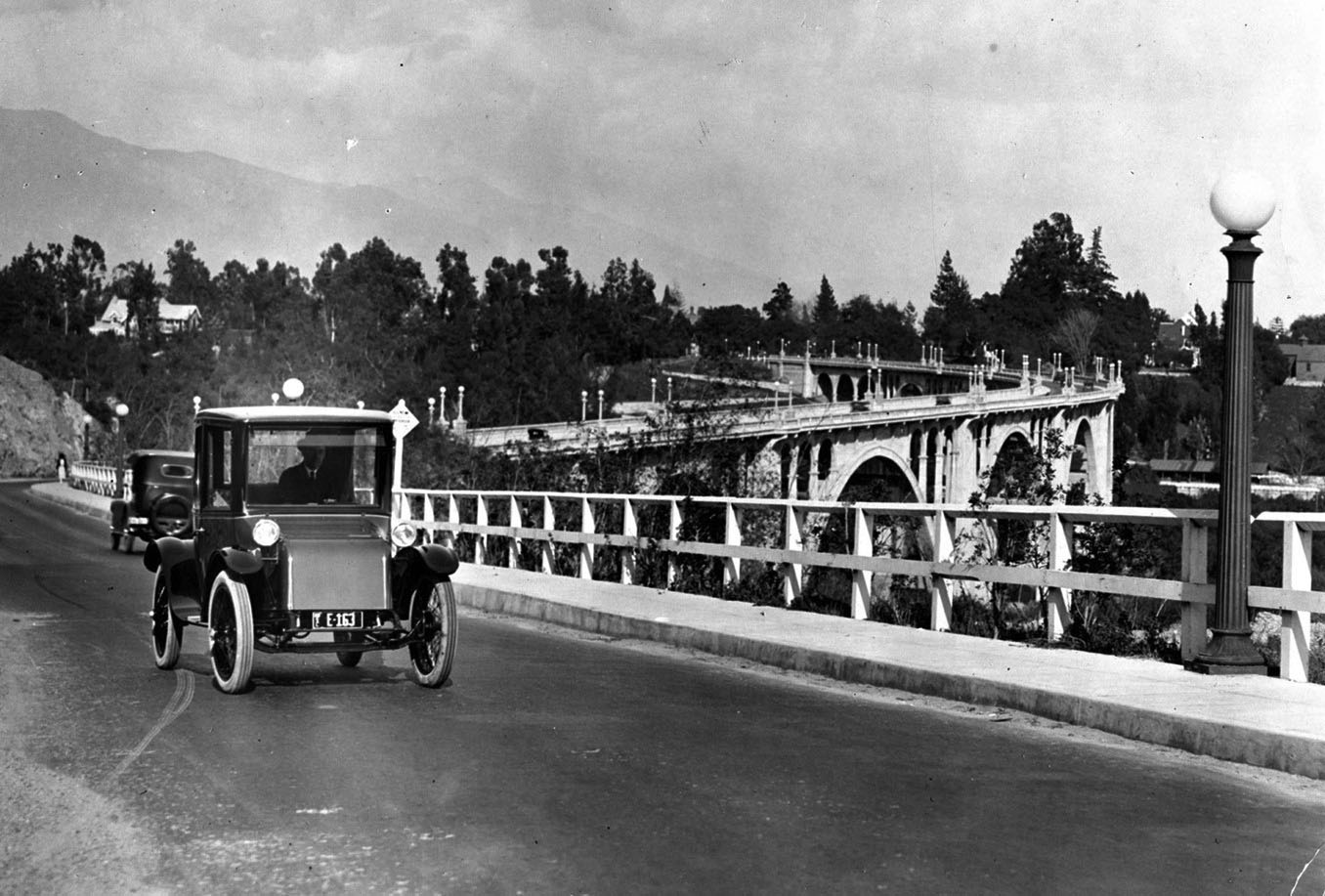 |
|
| (1920s)* - An electric car crosses the Colorado Street Bridge. Courtesy of the Pasadena Museum of History. |
Historical Notes The car seen above appears to be a 1920 Milburn Electric. People liked them because in many ways early electric cars outperformed their gas competitors. Electric cars didn’t have the smell, noise, or vibration found in steam or gasoline cars. They were easier to operate, lacked a manual crank to start, and didn’t require the same difficult-to-change gear system as gas cars. Electric cars became extremely popular in cities, especially with upper-class women who disliked the noisy and smelly attributes of gasoline-powered cars. The production of electric cars peaked in 1912. And while at the turn of the century electric cars had made up a good proportion of the market, advances in gasoline-powered vehicles meant that electric cars owned a smaller and smaller market share as time went on. When Henry Ford introduced the mass-produced and gas-powered Model T in 1908, it symbolized a death blow to the electric car. By 1912, a gasoline car cost only $650 while the average electric roadster sold for $1,750. In 1912 Charles Kettering also invented the first electric automobile starer. Effectively eliminating the hand crank, Kettering’s invention made the gas-powered auto even more attractive to the same drivers who had preferred electric cars. By 1935, electric cars had all but disappeared from the road.* |
Gamble House
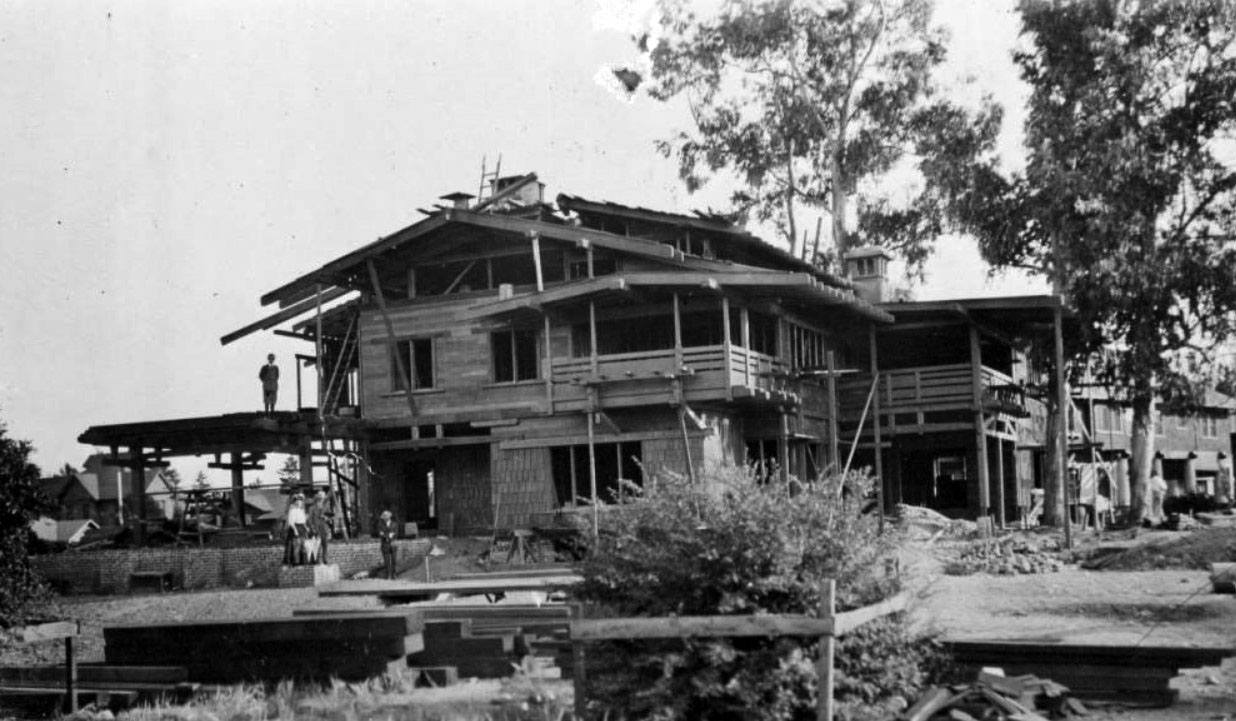 |
|
| (ca. 1909)^ - View showing the residence for D. B. Gamble under construction. |
Historical Notes The Gamble House was designed in 1908 by architects Greene & Greene. It was commissioned by David and Mary Gamble, of Cincinnati, Ohio, as a winter residence. David Berry Gamble, a second generation member of the Procter & Gamble Company in Cincinnati, had retired from active work in 1895, and with his wife, Mary Huggins Gamble, began to spend winters in Pasadena, residing in the area’s resort hotels. By 1907, the couple had decided to build a permanent home in Pasadena. In June of that year, they bought a lot on the short, private street, Westmoreland Place, passing up the more fashionable address, South Orange Grove, known at that time as “Millionaires’ Row.”^ |
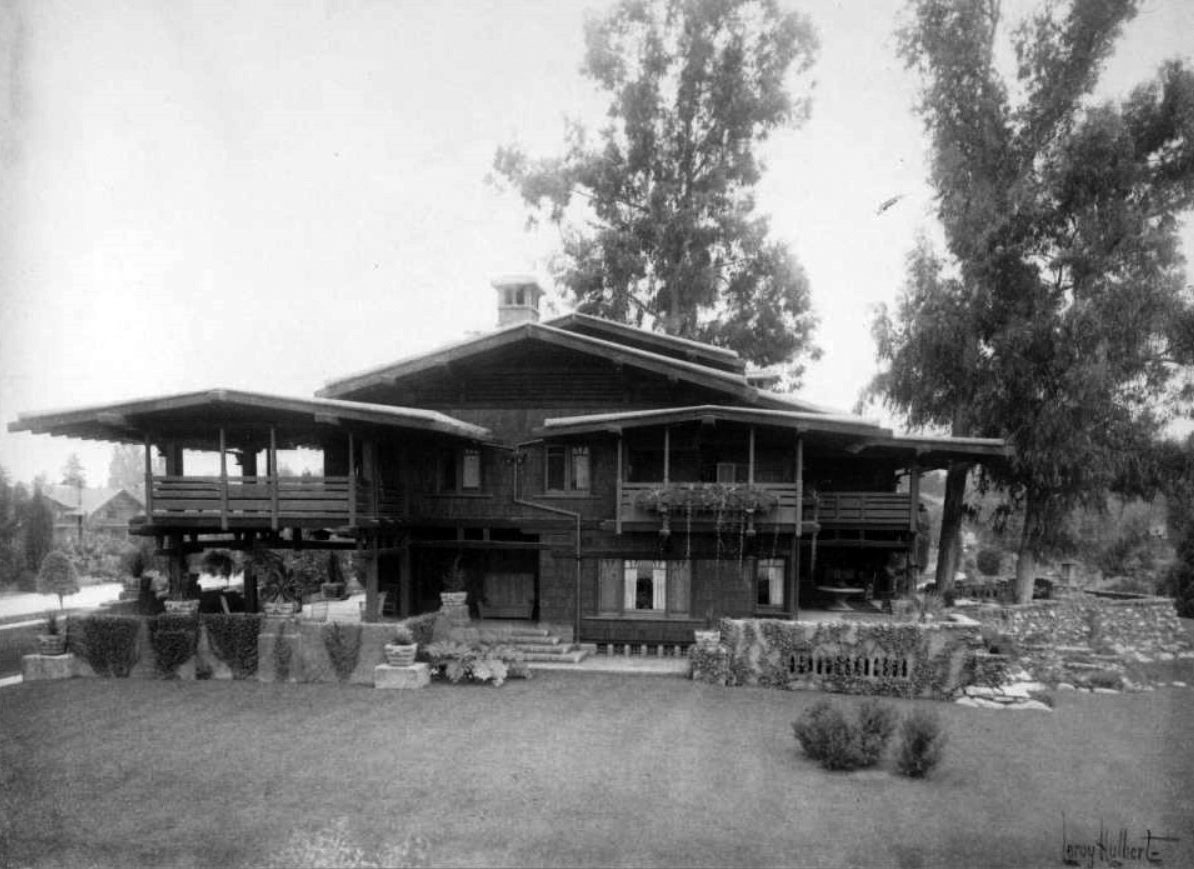 |
|
| (ca. 1909)^ - View showing the recently completed Gamble House, located at 4 Westmoreland Place, near the Arroyo Seco in Pasadena. |
Historical Notes Outdoor space was as important as the interior spaces. Exterior porches are found off three of the second-floor bedrooms and were used for sleeping or entertaining. The main terrace is privately beyond the rear facade of the residence. It has patterned brick paving with planting areas, a large curvilinear pond, and garden walls made with distinctive clinker bricks and boulders. Paths made with large water-worn stones from the nearby Arroyo Seco are reminiscent of running brooks crossing the lawns. The overall landscape design and constructed garden elements are integrated with the architectural proportion and detailing. The triple front door and transom feature a Japanese black pine motif in plated (more than one layer) leaded art glass, highlighting the Asian influence that runs throughout the house. *^ |
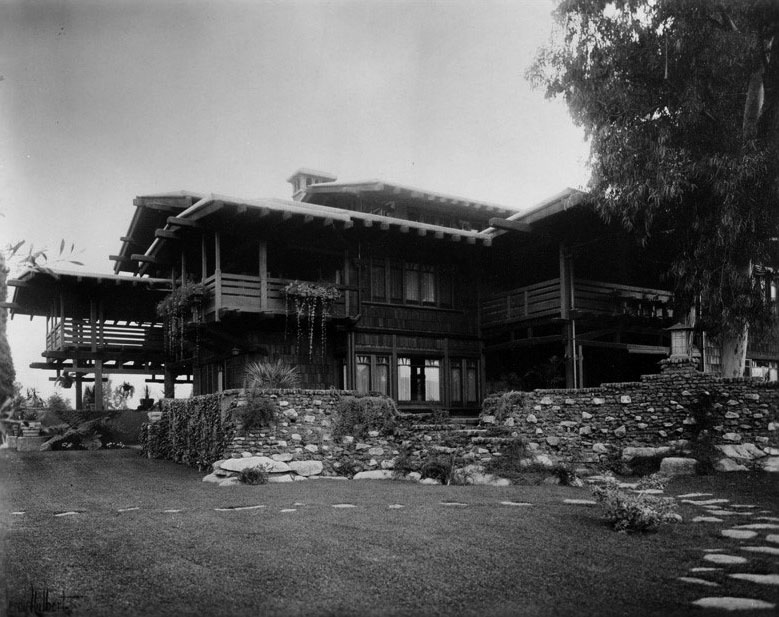 |
|
| (1947)^## – View showing the large arts and crafts style Gamble House with rock terrace and pathway. |
Historical Notes David and Mary Gamble lived in the house until their deaths in 1923 and 1929, respectively. Cecil Huggins Gamble and his wife Louise Gibbs Gamble began living in the house after Julia’s death in 1944, and briefly considered selling it. They soon changed their minds, however, when prospective buyers spoke of painting the interior teak and mahogany woodwork white! The Gambles realized the artistic importance of the house and it remained in the Gamble family until 1966, when it was deeded to the city of Pasadena in a joint agreement with the University of Southern California School of Architecture. ^ |
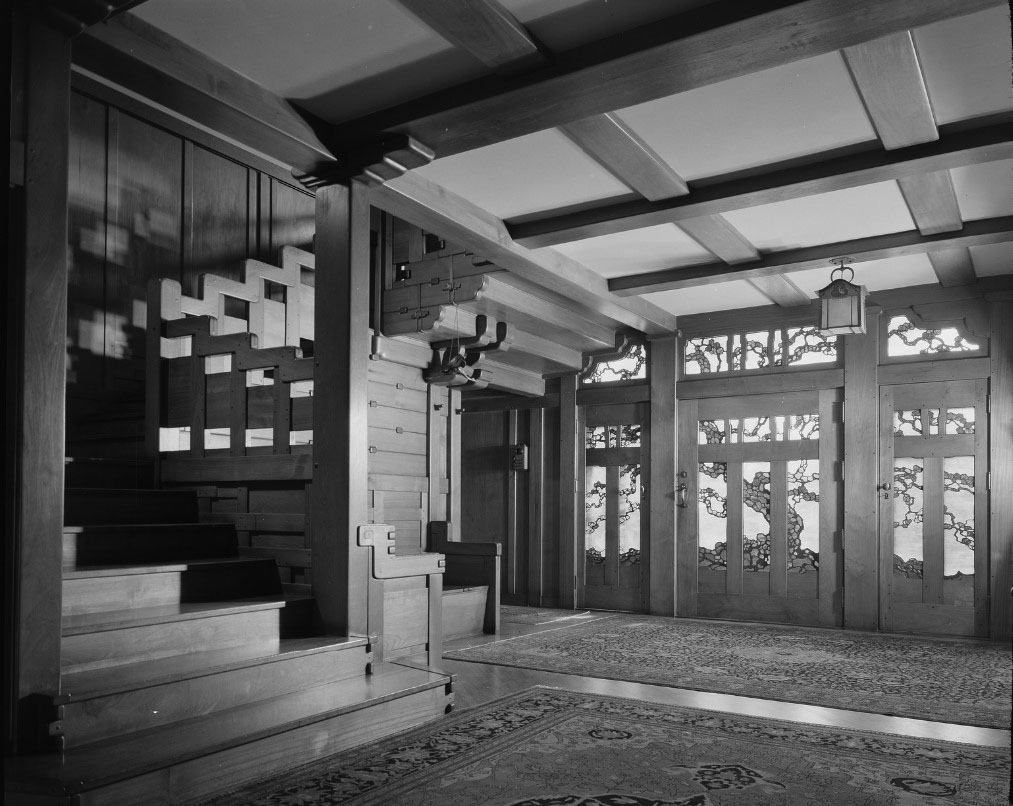 |
|
| (n.d.)#* – Interior view of the Gamble, David and Mary, residence [Gamble House]. Architects Charles and Henry Greene |
Historical Notes The Gamble House was built using multiple kinds of wood; the teak, maple, oak, Port Orford cedar, and mahogany surfaces are placed in sequences to bring out contrasts of color, tone, and grain. The woods, the low and horizontal room shapes, and the natural light that filters through the art glass exterior windows coexist with a relatively traditional plan, in which most rooms are regularly shaped and organized around a central hall. Although the house is not as spatially adventurous as the contemporary works of Frank Lloyd Wright or even of the earlier New England "Shingle Style," its mood is casual and its symmetries tend to be localized. *^ In 1966, the Gamble family turned the house over to the city of Pasadena in a joint agreement with the University of Southern California School of Architecture. The Gamble House was declared a National Historic Landmark in 1977.^ |
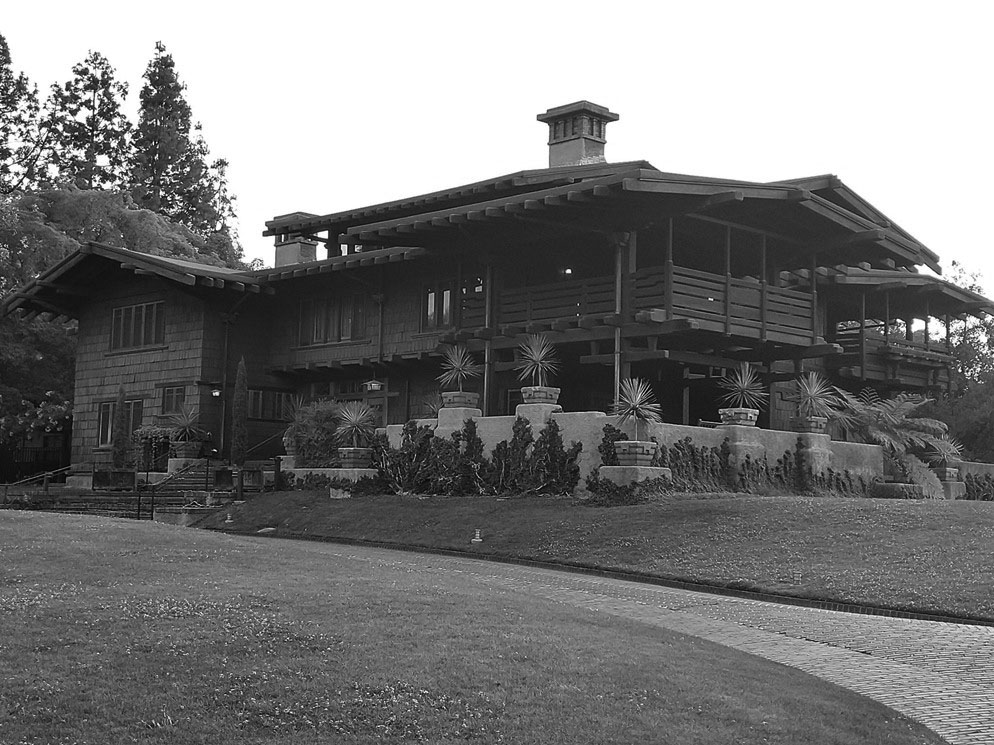 |
|
| (2021)* - Tha Gamble House - 4 Westmoreland Place, Pasadena. Photo by Celina Paternostro |
Historical Notes In 1985, the Gamble House played Dr. Emmett Brown’s home in Back to the Future. Today, the Gamble House serves as a house museum with tours offered most days; and two senior-year students of the USC School of Architecture are chosen to live in the home each year. The house was included in a list of all-time top 10 houses in Los Angeles in a Los Angeles Times survey of experts in December 2008.^ |
* * * * * |
Merritt Mansion
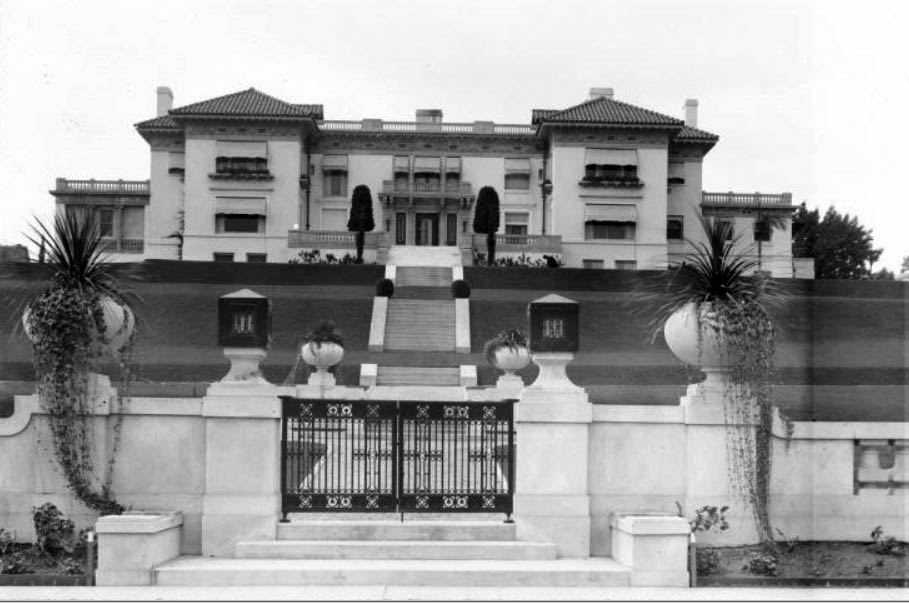 |
|
| (ca. 1916)^ – Street view of the large H.C. Merritt residence in Pasadena. The three-story mansion sits on top of a hill on a large estate located at 99 Terrace Drive and bounded on the north by Olcott Place and on the west by South Orange Grove Avenue. |
Historical Notes The Hulett C. Merritt mansion, also called the "Villa Merritt Ollivier", was featured in the opening scenes of The Millionaire, a popular TV series of the 1950s. Merritt's fortune was made largely in the railway and steel industries. The Merritt mansion was built on four acres for $1,100,000 in 1905-1908. This area was referred to locally as "Millionaires' Row" (per the City of Pasadena's Architectural and Historical Survey of 1997, which states: "The Hulett C. Merritt House is significant as the residence of one of Pasadena's most celebrated millionaires and foremost residents of South Orange Grove Blvd.").*^ |
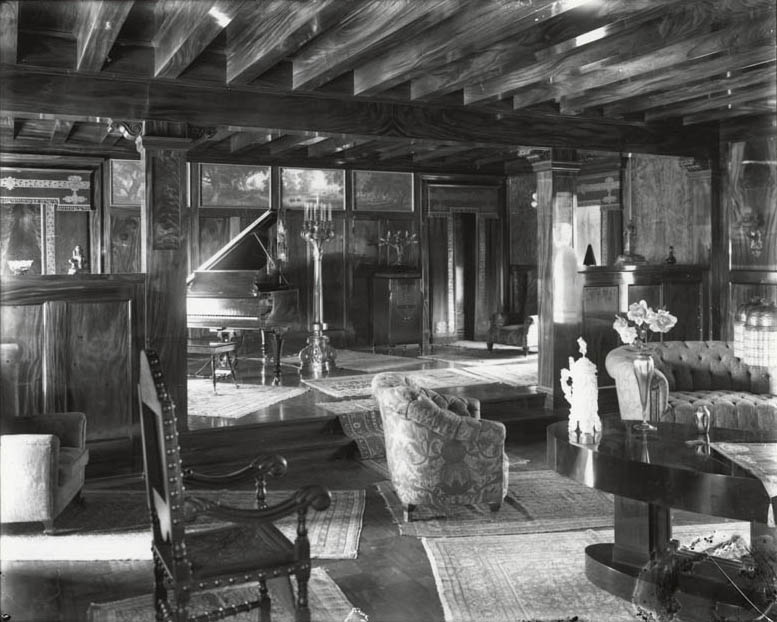 |
|
| (ca. 1915)^## - Interior view of the Merritt mansion showing the family room with piano and standing candelabra in the background. Floor rugs are spread out over the hardwood floors. Note the beautiful wood panels and exposed ceiling beams. |
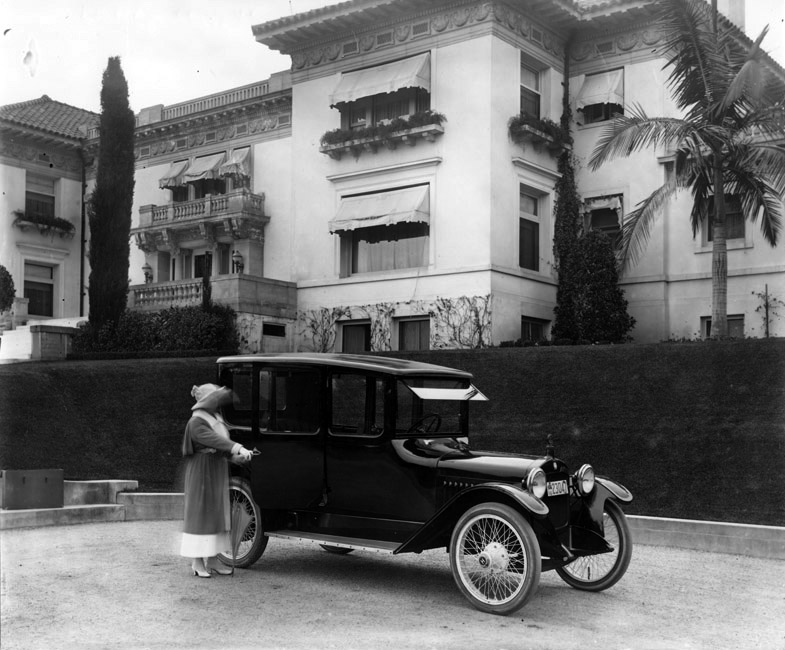 |
|
| (1920s)^## - View of a woman (possibly Mrs. Merritt) with umbrella in hand entering a late model car in front of the Merritt mansion. |
Historical Notes In 1956, after Hulett's death, the property was purchased by Herbert W. Armstrong from Hulett's four surviving grandchildren because it was adjacent to Ambassador College. Villa Merritt Ollivier was renamed "Ambassador Hall" and the college subsequently obtained permission to close Terrace Drive. Thereafter, the residence and street address for the former Villa Merritt Ollivier was redesignated as 100 S. Orange Grove Blvd., Pasadena. In the 1960s Ambassador College built two modern classroom buildings flanking Ambassador Hall. A formal Italian sunken garden, with a plaza in the center, joined the three buildings and the garden into an academic center. In 1997, the college closed. After many years of vacancy, the mansion and former classrooms are now part of an event venue called the Ambassador Mansions & Gardens.*^ |
* * * * * |
.jpg) |
|
| (1913)++# - Postcard view depicting Pasadena's "new" Post Office located on the northwest corner of E. Colorado Boulevard and Garfield Avenue. The Post Office was built in 1913 and designed by architect, Oscar Wenderoth. |
Historical Notes The Post Office Building is still standing today. |
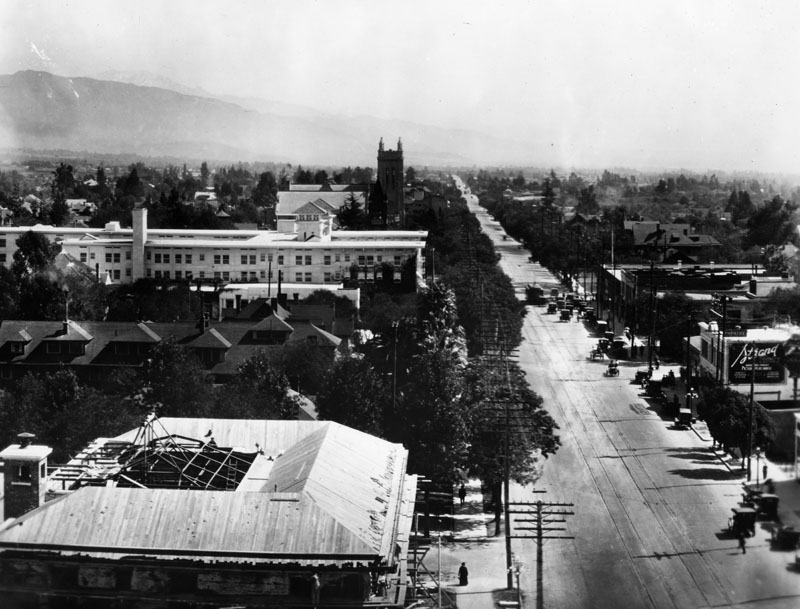 |
|
| (1917)* - Colorado Boulevard in Pasadena looking east from the Post Office. |
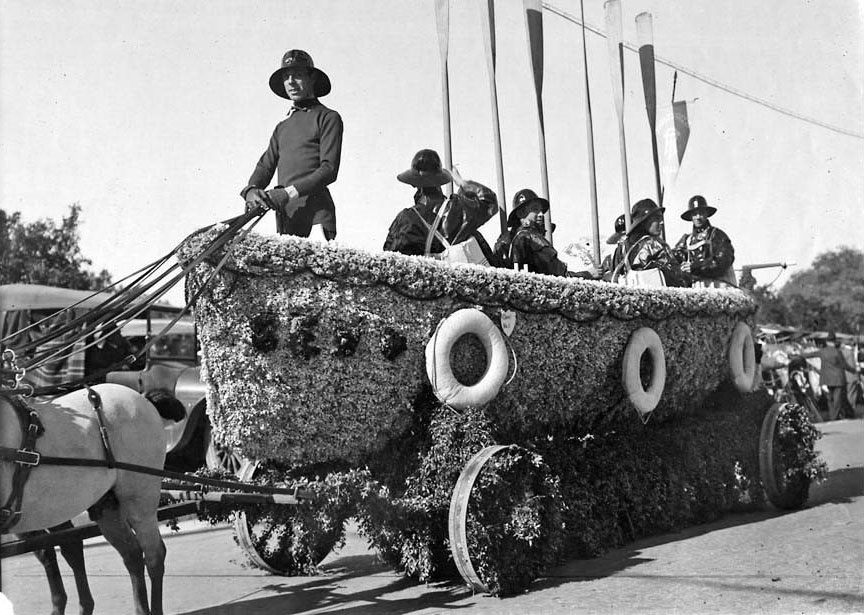 |
|
| (1918)^^* - The Adolphus Busch Estate float won first prize, class F, commercial float category in the Jan. 1, 1918 Rose Parade. First prize was a $50 silver trophy and blue banner. |
Huntington Hotel
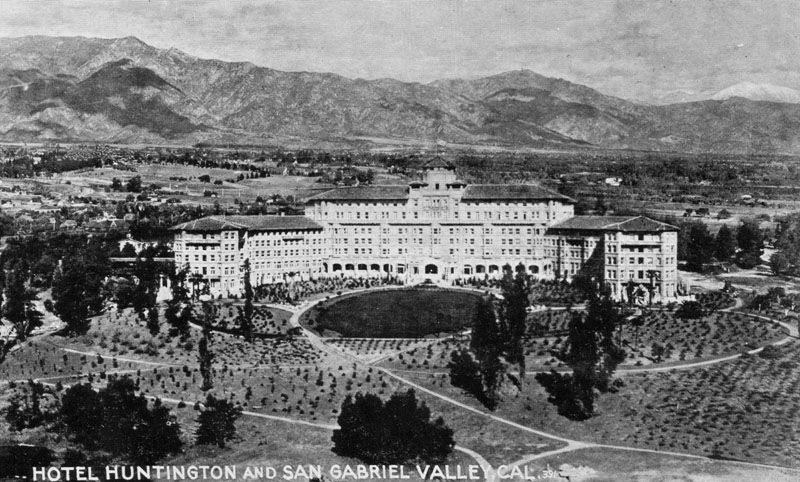 |
|
| (ca. 1910s)* - Postcard view of the Huntington Hotel in Pasadena, and the San Gabriel Valley behind it. |
Historical Notes The above view is that of the original hotel on the site, built in 1906 by General Wentworth, a Civil War veteran, and designed by Charles Frederick Whittlesey in Spanish Mission Revival-style. It opened in February 1907 as the Hotel Wentworth, but closed its doors after its first season. It was purchased by Henry E. Huntington in 1911 and reopened in 1914 as The Huntington Hotel after redesign by the architect Myron Hunt. The hotel remained under Huntington's management until 1918.*^ |
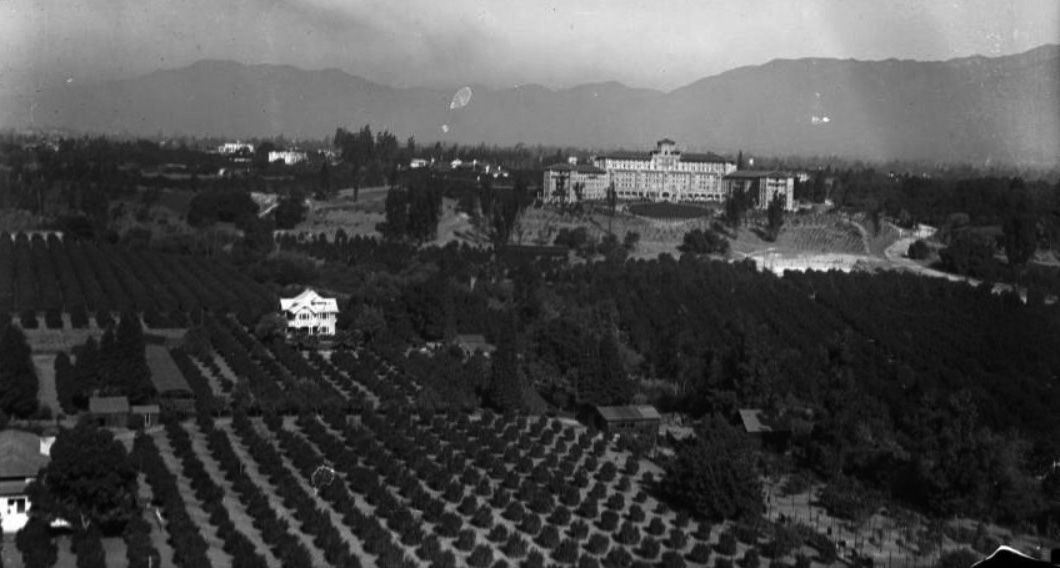 |
|
| (1913)#* - An aerial view of the front of the Huntington Hotel, at the corner of Oak Knoll and Wentworth, taken from a dirigible. In the foreground there are a few houses surrounded by extensive orchards, and the San Gabriel Mountains are in the background. |
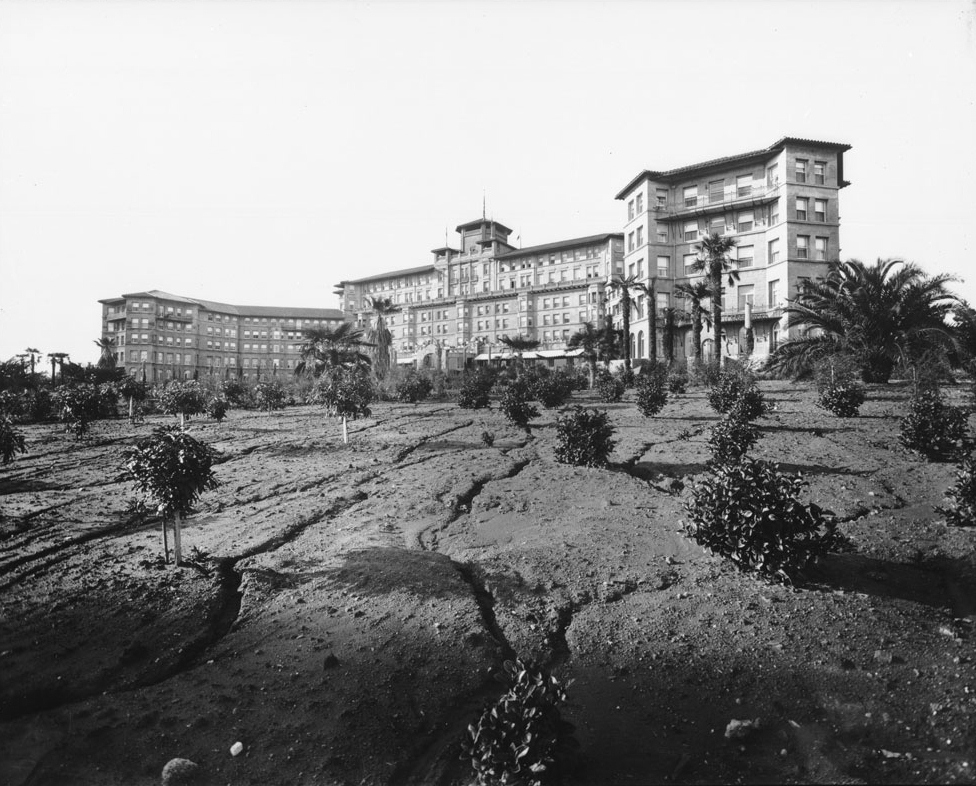 |
|
| (ca. 1917)**# - Exterior view of the rear of the Huntington Hotel in Pasadena, showing the newly landscaped gardens. |
Historical Notes The Huntington Hotel, a Mission style resort hotel "where the sunshine spends the winter", was designed by architects Myron Hunt and Charles Whittlesey and built from 1906 to 1916. The hotel is situated on 23 acres at the base of the San Gabriel Mountain foothills with 380 guestrooms, suites, and cottages.* |
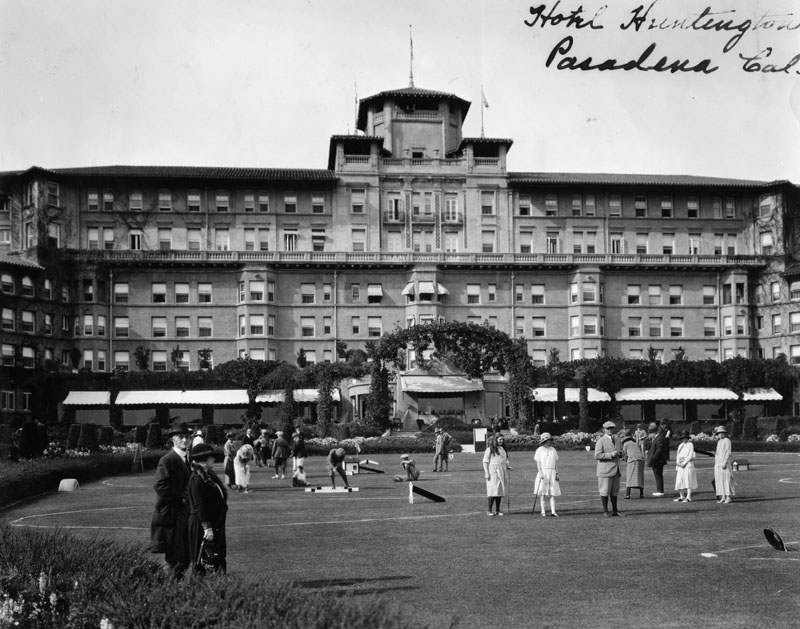 |
|
| (ca. 1920)* - Exterior view of the Huntington Hotel in Pasadena. Guests are playing on the famous obstacle golf course in front of the hotel. |
Historical Notes California's first outdoor Olympic-size swimming pool was added in 1926, when the hotel, formerly a winter resort, began opening year-round. The hotel was later owned by Stephen W. Royce, who sold it to the Sheraton Corporation in 1954. It was subsequently renamed The Huntington Sheraton.*^ |
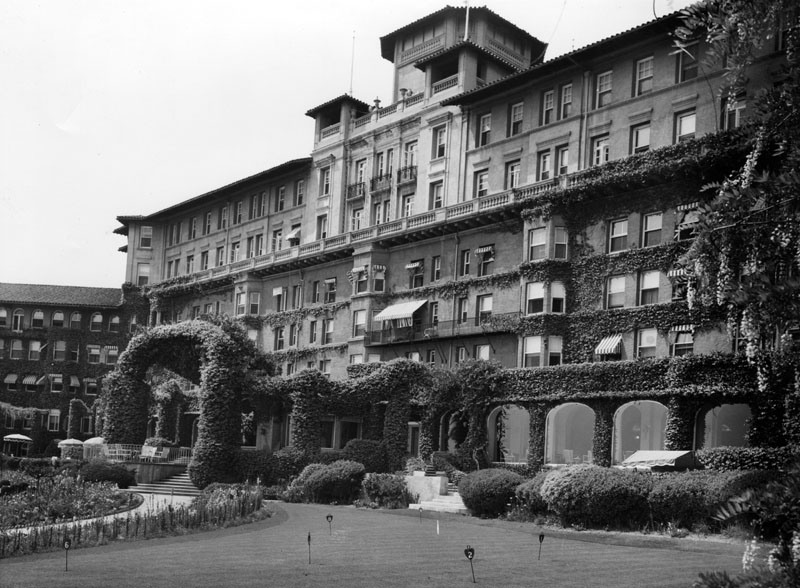 |
|
| (n.d.)* - Exterior view of the ivy-covered Huntington Hotel, located at 1401 S. Oak Knoll Avenue at Wentworth Avenue, in Pasadena. |
Historical Notes The Huntington Hotel became the Huntington Sheraton in the 1950s; it was restored to its turn-of-the-century grandeur by Ritz-Carlton in 1991, after languishing for several years due to earthquake damage.* |
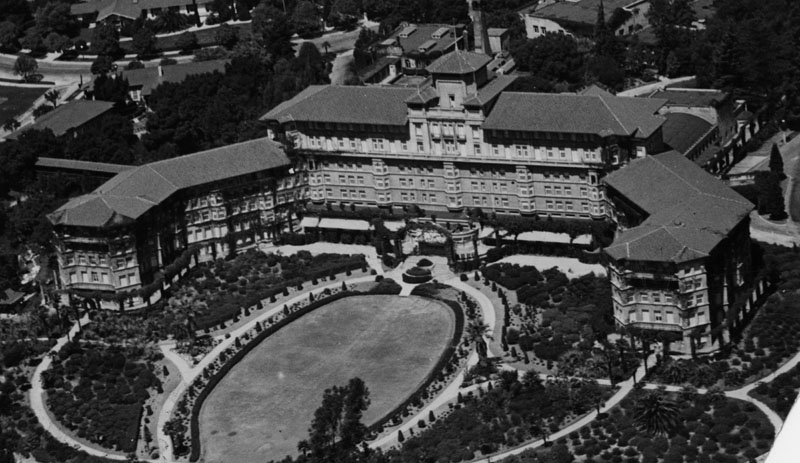 |
|
| (ca. 1920)* - Aerial view of the Huntington Hotel in Pasadena. View also shows the hotel's immense oval shaped lawn and the many roads in front of the building. |
Historical Notes The hotel closed in 1985 after the main building ceased to meet new earthquake codes, which had been changed due to the disastrous 1985 Mexico City earthquake. It sat vacant until it was demolished in 1989, though the bungalows remained in operation as a hotel.*^ |
 |
|
| (1930)++# – View showing the Hotel Huntington sign with cars passing at rear on Oak Knoll. |
 |
|
| (1948)##^^ - View from the lobby of the Huntington Hotel. Photo by Julius Shulman |
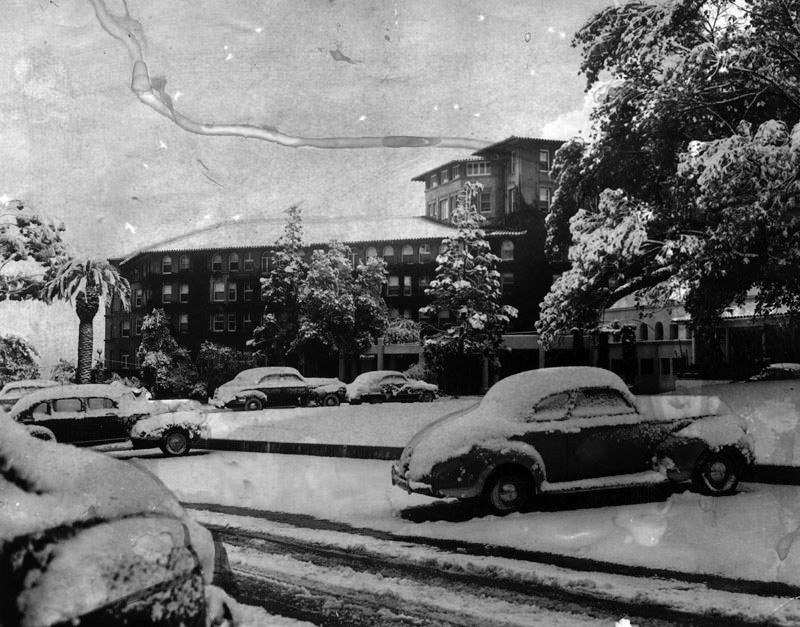 |
|
| (1949)++# - Dreaming of winter. The Huntington Hotel parking lot during the Great Snowstorm of January 1949. |
Historical Notes From Jan. 9 through 12, 1949, snow fell in Pasadena, Los Angeles and Southern California. In a Jan. 10, 1999, Los Angeles Times article, columnist Cecilia Rasmussen wrote: “On Jan. 10, 1949, in the middle of the worst housing shortage in Los Angeles history, more than half an inch of snow covered the Civic Center. The San Fernando Valley was pelted with the unfamiliar white stuff for three days, accumulating almost a foot. The Rose Bowl was transformed into “a dishpan full of milk,” by one account. An Alhambra hardware store put up a sign that said, “Snow Plows for Rent–Hurry!” A snowman appeared in Eagle Rock, wearing a sombrero, and the city of Reno, Nev., sent L.A. a snow shovel. In a semitropical climate where January sometimes feels like June, palm-lined boulevards were transformed into winter wonderlands. Altadena residents turned their evergreen-lined Christmas Tree Lane on snow-swaddled Santa Rosa Avenue into a miniature ski run, and golfers swapped nine irons for snow skis…" ^^* |
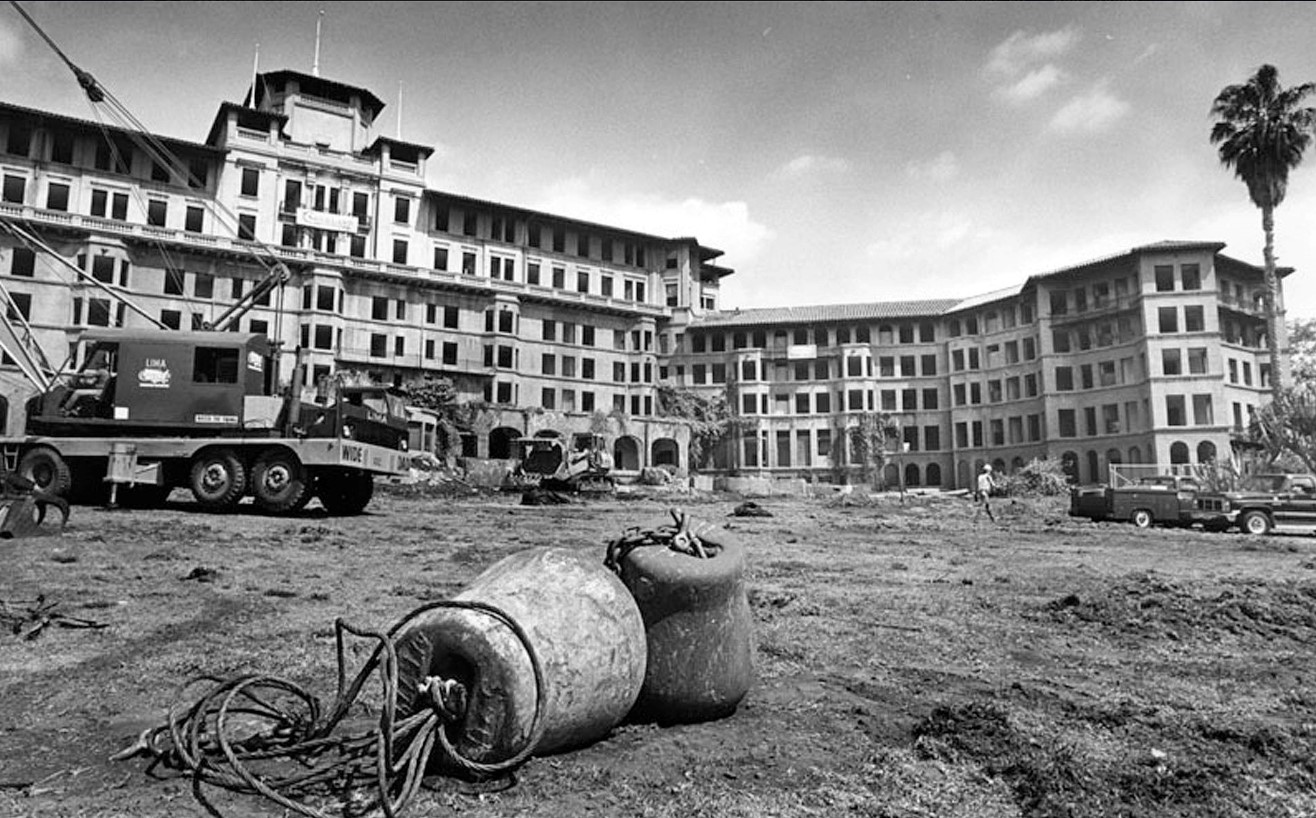 |
|
| (1989)* - View of Pasadena's Huntington Hotel shortly before its demolition. It shared the same architect as the Ambassador Hotel: Myron Hunt. Photo by Mike Mullen |
Historical Notes A new building, almost exactly replicating the original, opened in March 1991 as the 383-room Ritz-Carlton, Huntington Hotel. It was renamed The Ritz-Carlton, Huntington Hotel & Spa in April 1998. In 2006 the hotel underwent renovations, changed hands, and re-opened in 2007 managed by Langham Hotels International.*^ |
Huntington Mansion
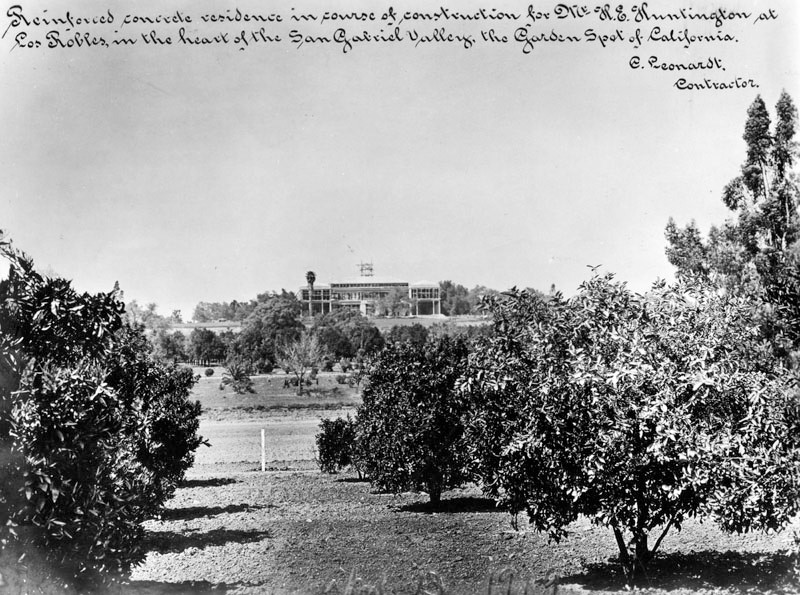 |
|
| (1909)* - View showing the Henry E. Huntington mansion under construction, April 13, 1909. The note on the photograph reads, "Reinforced concrete residence in course of construction for Mr. H. E. Huntington at Los Robles, in the heart of the San Gabriel Valley, the Garden Spot of California." |
Historical Notes In 1905, railroad and real estate magnate Henry Huntington commissioned an engineer E.S.Code to translate his own simple sketch of what he wanted into a buildable design. By 1908, when he asked the distinguished Los Angeles architect Myron Hunt to take the project forward, he was already being influenced by the taste of his uncle’s widow, Arabella Huntington, whom he would marry in 1913. Retaining many of the features of the original plans, Hunt’s design subtly raised the game, removing Code’s neo-Palladian mannerisms, and restricting exterior classical ornament to the main compositions of the north and south fronts. To these he added a small porte cochere for the main entry, and the large peristylar loggia on the east, which to this day remains the building’s most distinguished architectural feature.^ |
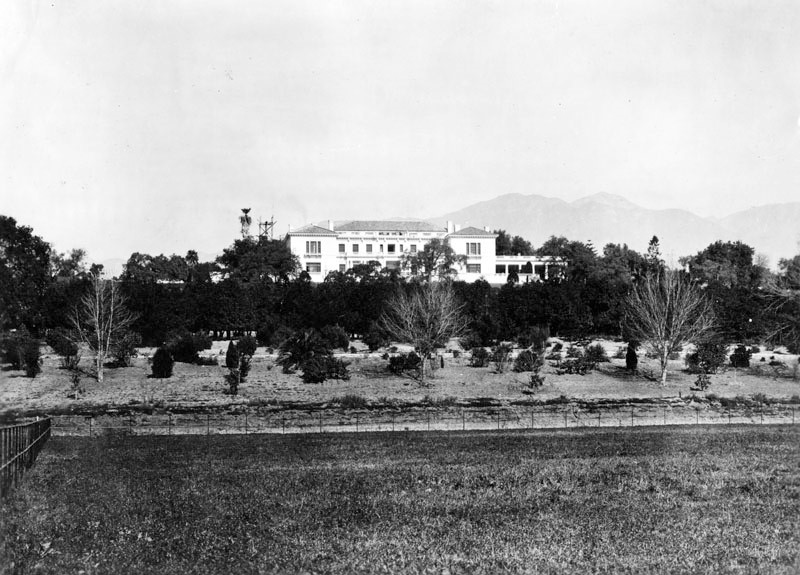 |
|
| (ca. 1915)* - View from a lower level of the Henry E. Huntington mansion, built on a rise overlooking the gardens and grounds of the estate. |
Historical Notes As a landowner and businessman, Henry Edwards Huntington, (1850–1927), played a major role in the growth of southern California. Huntington was born in 1850, in Oneonta, New York, and was the nephew and heir of Collis P. Huntington, (1821–1900), one of the famous "Big Four" railroad tycoons of 19th century California history. In 1892, Huntington relocated to San Francisco with his first wife, Mary Alice Prentice, and their four children. He divorced Mary Alice Prentice in 1906, and in 1913, married his uncle's widow, Arabella Huntington, (1851–1924), relocating from the financial and political center of northern California, San Francisco, to the state's newer southern major metropolis, Los Angeles. He purchased a property of more than 500 acres that was then known as the "San Marino Ranch", and went on to purchase other large tracts of land in the Pasadena and Los Angeles areas of Los Angeles County for urban and suburban development.*^ |
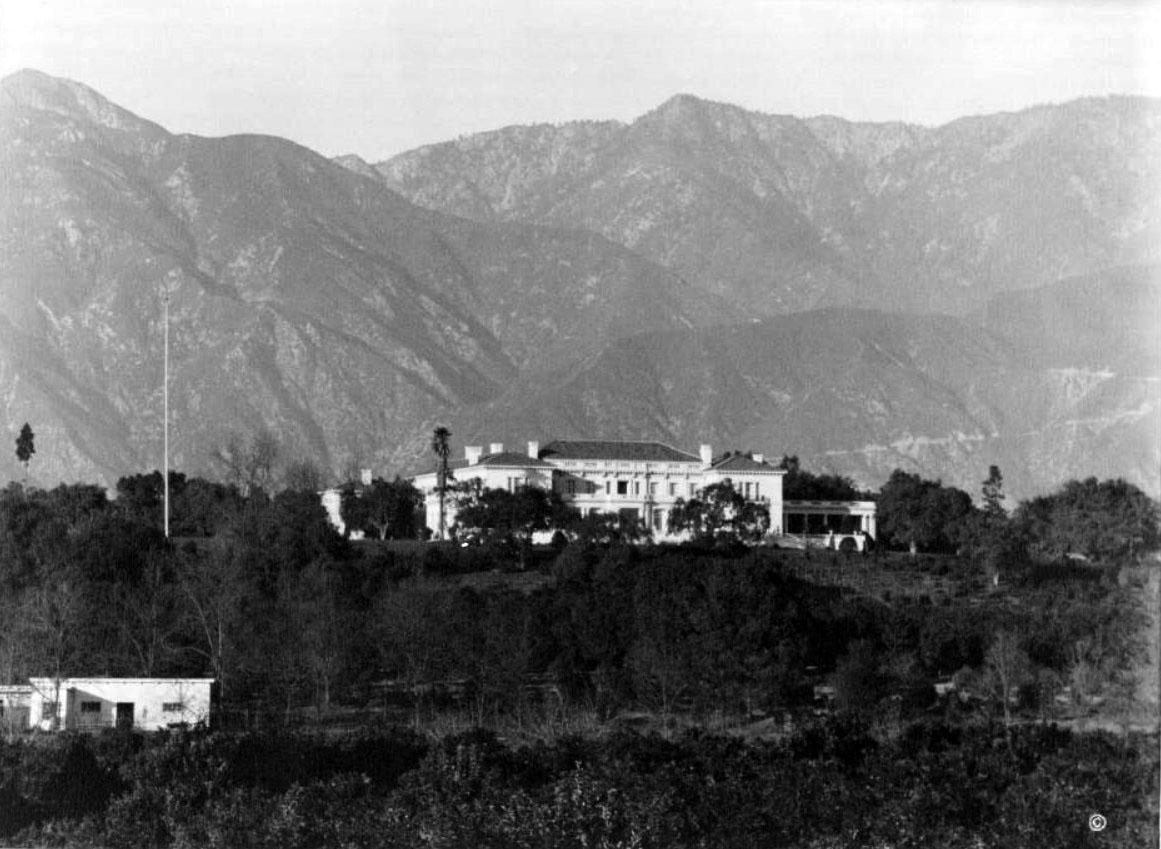 |
|
| (n.d.)** - View looking north showing the Huntington Mansion with the San Gabriel Mountains in the background. |
Historical Notes As president of the Pacific Electric Railway Company, the regional streetcar/public transit system for the Los Angeles metropolitan area and southern California and also of the Los Angeles Railway Company, (later the Southern California Railway), Huntington spearheaded urban and regional transportation efforts to link together far-flung communities, supporting growth of those communities as well as promoting commerce, recreation, and tourism. He was one of the founders of the City of San Marino, incorporated in 1913.*^ |
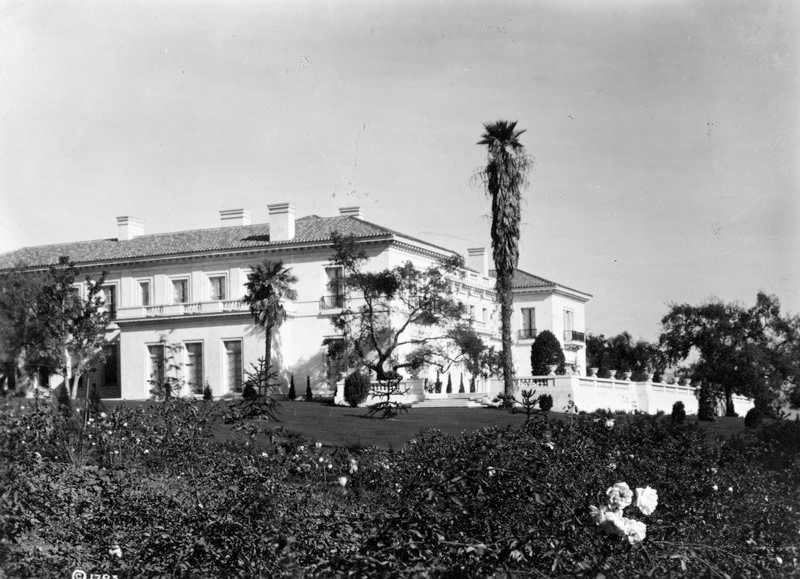 |
|
| (ca. 1911)* – View showing the home of Henry E. Huntington, with gardens. Mr. Huntington donated his home and collections to the people of the State of California for use as the Huntington Library and Art Gallery and the Huntington Botanical Gardens. |
Historical Notes The Huntington Mansion originally came in at 55,000 square feet. The south façade and terrace reflects Italian and Spanish Renaissance traditions of country house architecture, and the north façade is more in the French tradition. As a whole, the house is a classic exercise in the emerging Mediterranean style of early-20th-century Californian architecture.^ |
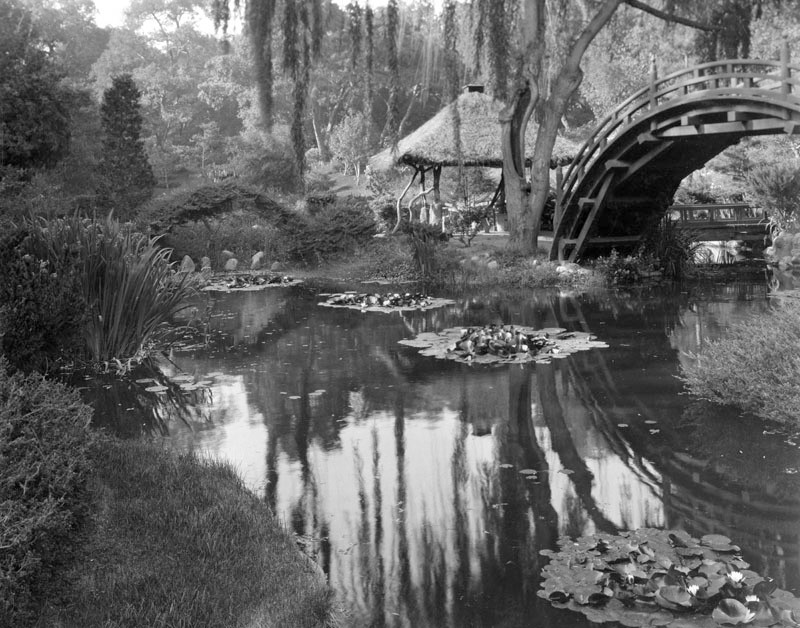 |
|
| (1913)* – View showing the Japanese Garden after the completion of landscape at the Huntington estate. |
Historical Notes Henry Huntington's superintendent, William Hertrich, was instrumental in developing the various plant collections that comprise the foundation of the Botanical Gardens. Together, they molded the working ranch into a botanical collection of rare and exotic plants. They searched local nurseries and visited other plant collectors in the area to find mature and unique specimens. Mr. Huntington imported plants from many parts of the world to experiment with their cultivation in Southern California.^ |
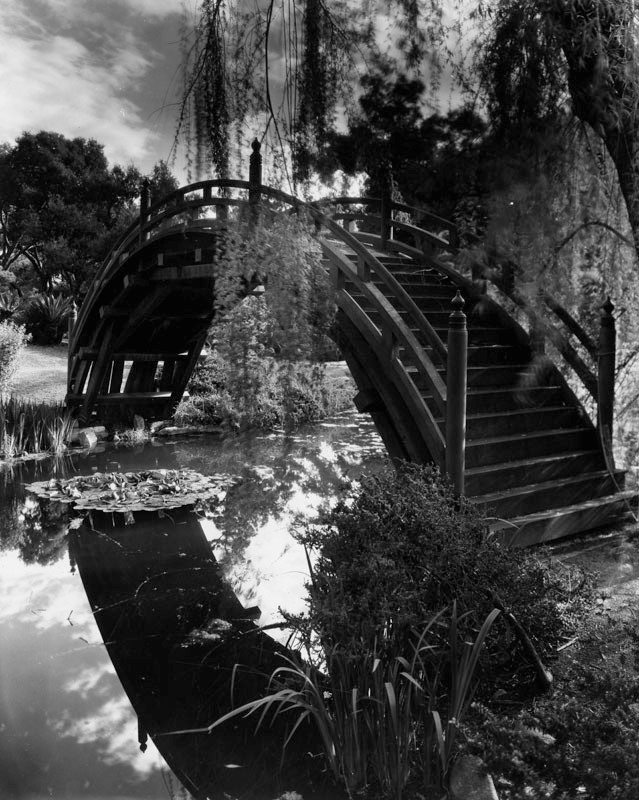 |
|
| (n.d.)* – Close-up view of the Japanese Gardens of the Henry E. Huntington Library and Art Gallery. The Botanical Gardens are a part of the trust left by Mr. Huntington to the people of California. |
Historical Notes The garden was completed in 1912 and opened to the public in 1928. It features the drum or moon bridge, a large bell, the authentic ceremonial teahouse Seifu-an (the Arbor of Pure Breeze), a fully furnished Japanese house, koi-filled ponds, the Zen Garden, and the bonsai collections with hundreds of trees.*^ |
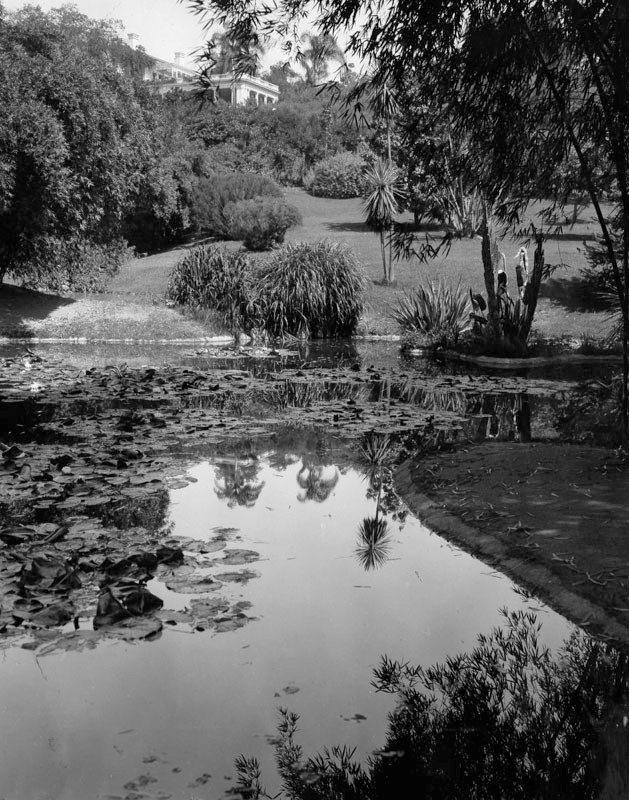 |
|
| (1916)* - Lily pond on the Huntington estate, with a view of the residence up on the hill in the background. |
Historical Notes The Lily Ponds were heated at the time to maintain the giant-leafed Amazon water lily during the relatively cool Southern California winters. Huntington and Hertrich also worked together on the Palm, Desert, and Japanese gardens and planned the North Vista and the landscaping around the mansion. Today, forty gardeners, a curatorial staff of seven, and more than 100 volunteers maintain the botanical collections.^ |
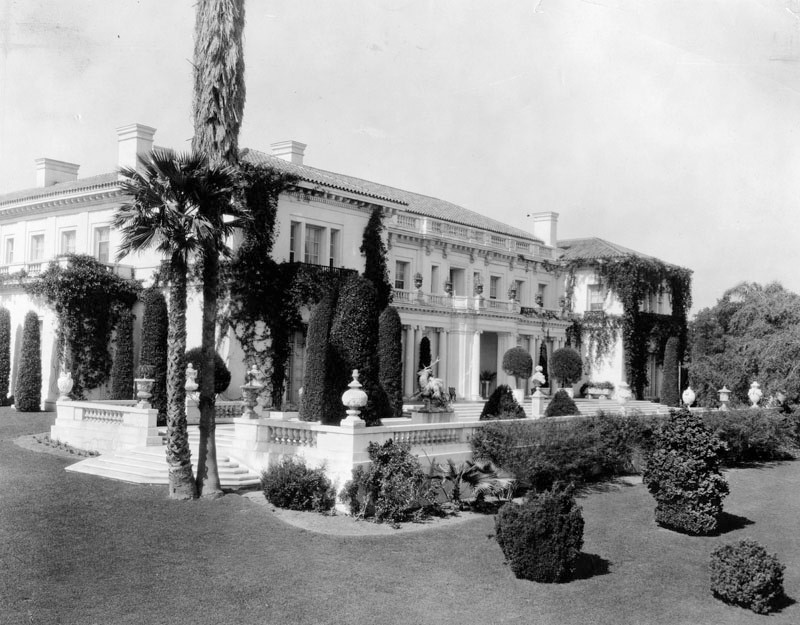 |
|
| (ca. 1930)* - View of the Huntington Art Gallery, formerly the home of Mr. and Mrs. Henry E. Huntington. |
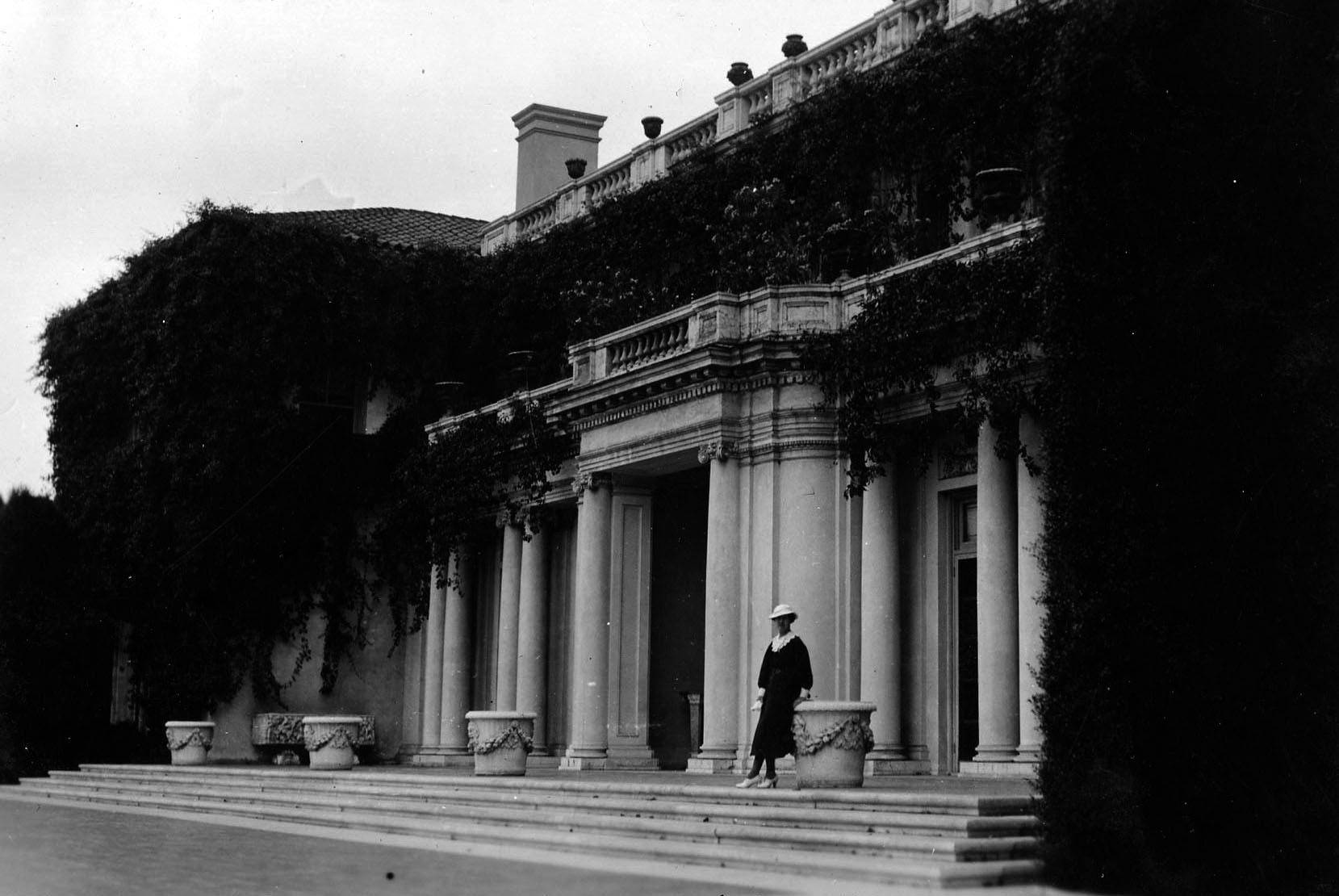 |
|
| (1935)^^# - View shows Grace McCarthy (photographer) standing before the ivy-covered Huntington Art Gallery building in San Marino. |
Historical Notes The Huntington Art Gallery, originally Henry and Arabella’s home, was designed by Myron Hunt and Elmer Grey. It was constructed from 1909 to 1911 and comprises 55,000 square feet. A 2008 renovation and adaptive reuse was led by Earl Corp. and Architectural Resources Group. |
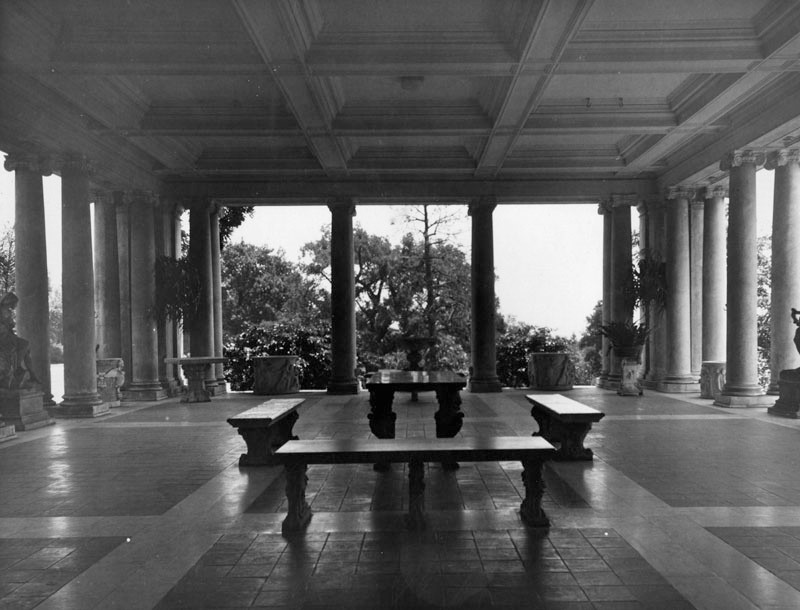 |
|
| (1937)* - Loggia at the eastern end of the Henry E. Huntington Library in San Marino. |
Huntington Library and Art Gallery
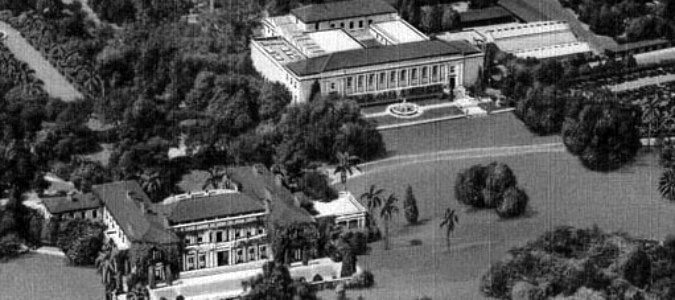 |
|
| (n.d.) – Postcard view showing the Henry E. Huntington Library and Art Gallery. The Huntington Mansion is seen on the left and the Library Building is to the right. |
Historical Notes Huntington's interest in art was influenced in large part by his second wife, Arabella Huntington, (1851–1924), and with art experts to guide him, he benefited from a post-World War I European market that was "ready to sell almost anything". Before his death in 1927, Huntington amassed "far and away the greatest group of 18th-century British portraits ever assembled by any one man". In accordance with Huntington's will, the collection, then worth $50 million, was opened to the public in 1928.*^ |
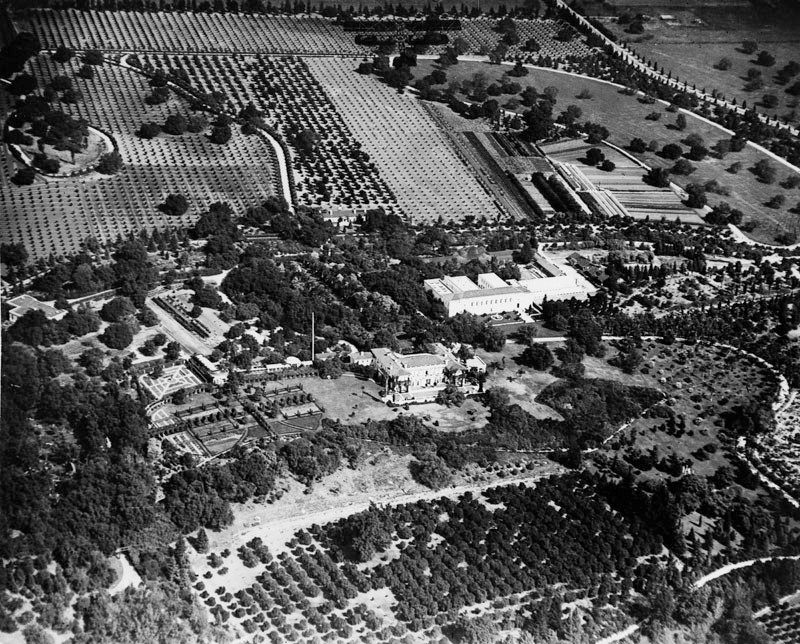 |
|
| (1920s)* - Aerial view looking north showing the Huntington Library and Art Gallery in San Marino. |
Historical Notes In addition to the library, the institution houses an extensive art collection with a focus in 18th and 19th-century European art and 17th to mid-20th-century American art. The property also includes approximately 120 acres of specialized botanical landscaped gardens, most notably the "Japanese Garden", the "Desert Garden", and the "Chinese Garden" (Liu Fang Yuan).*^ |
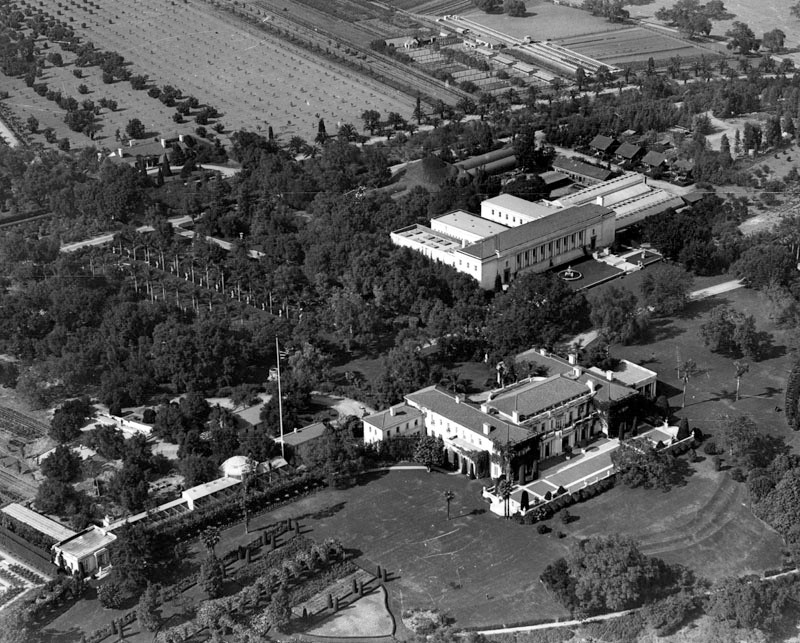 |
|
| (1924)* – Close-up aerial view of the Huntington Library and Art Gallery. The large new Library Building (upper-right) was constructed in 1920. Note the tall flag pole at center-left. |
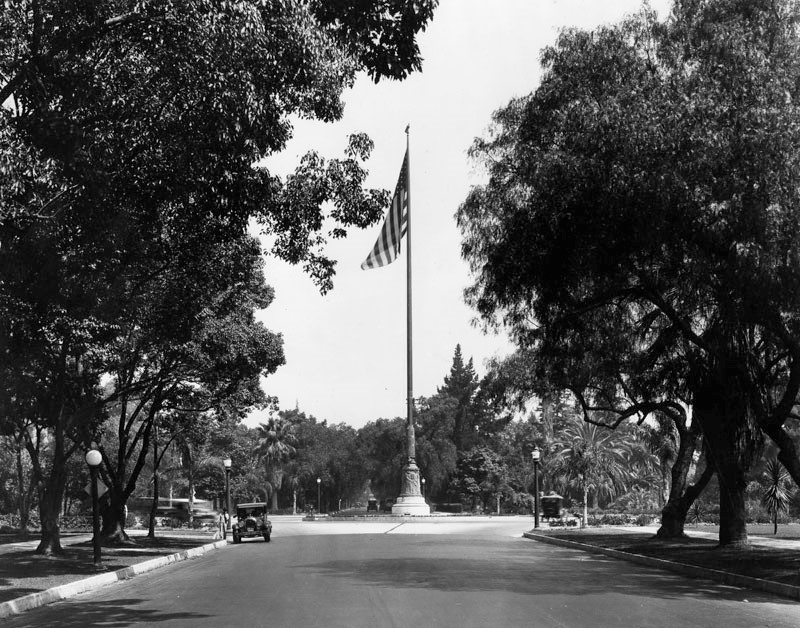 |
|
| (1920s)* - View showing a very large flag pole in the center of a wide road leading up to the Huntington Library. |
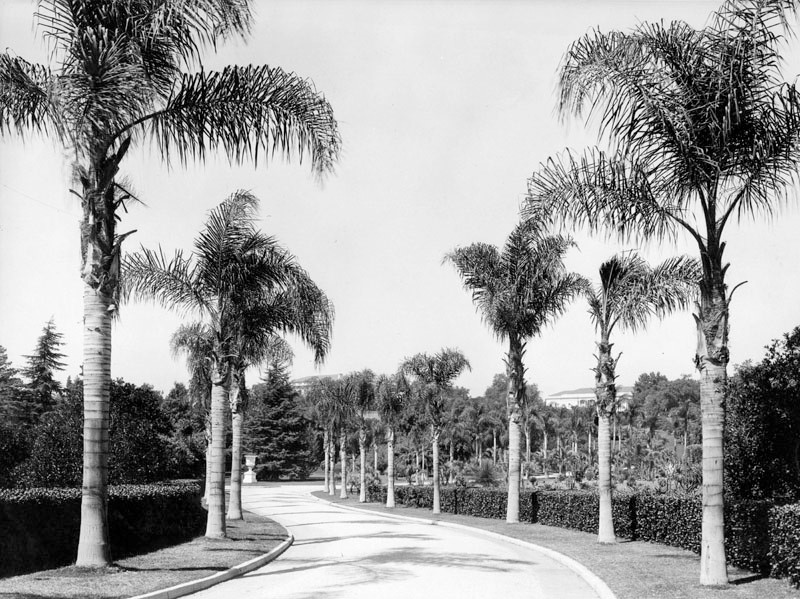 |
|
| (n.d.)* - Main entrance to Huntington Library from Huntington Drive. The residence is seen on the hill in the distance. A palm-lined drive amid the lush gardens on the grounds. |
 |
|
| (1924)^## - Henry E. Huntington Library and Art Gallery, 1151 Oxford Avenue; shows formal Neo-Classical style building, columns between paned windows, and statuary. |
Historical Notes The building was constructed in 1920, at which time the Library was transferred from New York to San Marino. It is now being used extensively by scholars and is also serving the public through exhibitions of rare books and manuscripts from the collections. |
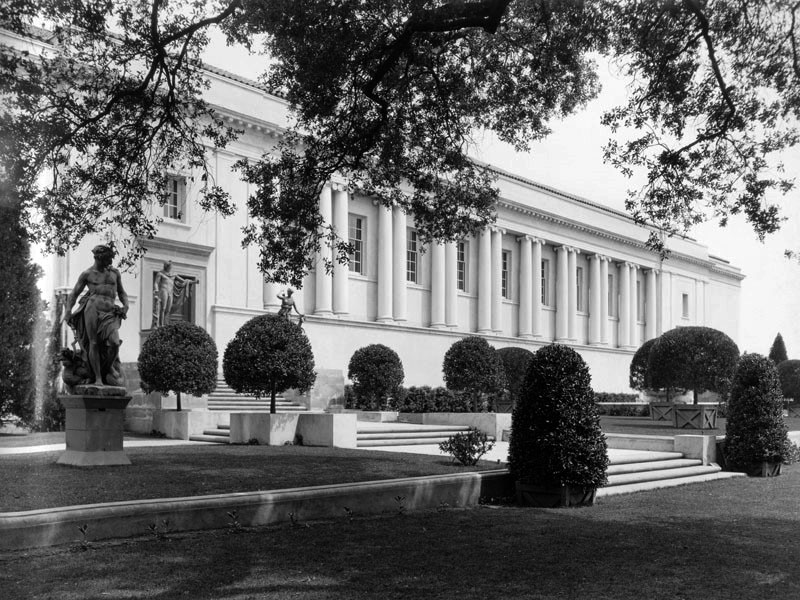 |
|
| (1923)^## - Closer view looking northeast of the neo-Classical Style Huntington Library Building with statues in front. |
Historical Notes The Library building was designed in 1920, by the southern California architect Myron Hunt in the Mediterranean Revival style. Hunt's previous commissions for Mr. and Mrs. Huntington included the Huntington's residence in San Marino in 1909, and the Huntington Hotel in 1914.*^ |
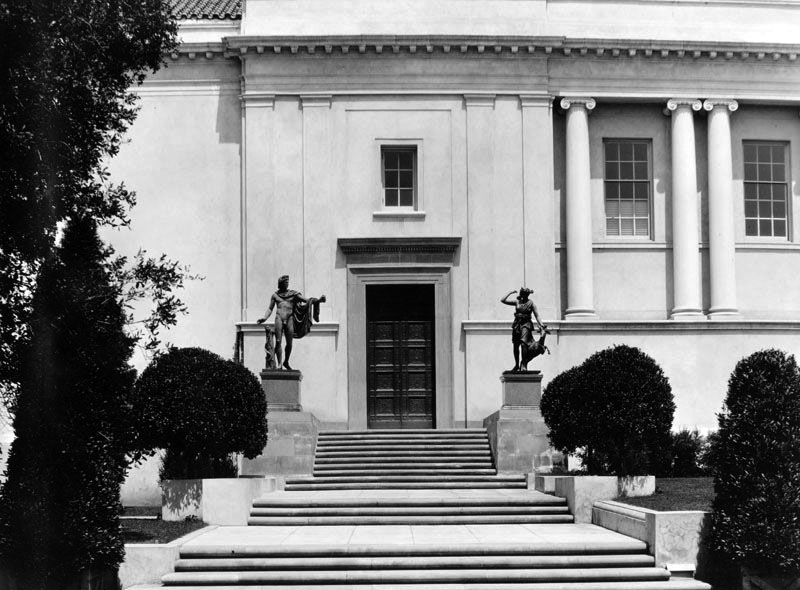 |
|
| (1923)^## - Close-up view of one of the two main entrances to the Huntington Library fronted by two imposing life-size statues. |
Historical Notes Today, the library contains a substantial collection of rare books and manuscripts, concentrated in the fields of British and American history, literature, art, and the history of science. Spanning from the 11th century to the present, the library's holdings contain 7 million items, over 400,000 rare books, and over a million photographs, prints, and other ephemera. Highlights include one of 11 vellum copies of the Gutenberg Bible known to exist, the Ellesmere manuscript of Chaucer ca. 1410, and letters and manuscripts by George Washington, Thomas Jefferson, Benjamin Franklin, and Abraham Lincoln. It is the only library in the world with the first two quartos of Hamlet; it holds the manuscript of Benjamin Franklin's autobiography, Isaac Newton's personal copy of his Philosophiae Naturalis Principia Mathematica with annotations in Newton's own hand. The first seven drafts of Henry David Thoreau's Walden, John James Audubon's Birds of America, and first editions and manuscripts from authors such as Charles Bukowski, Jack London, Alexander Pope, William Blake, Mark Twain, and William Wordsworth.*^ |
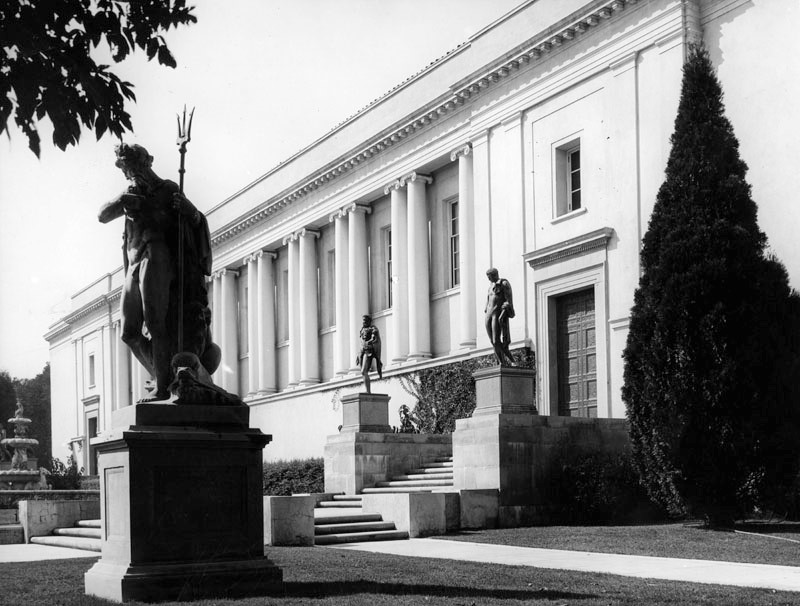 |
|
| (1937)* - General view of the exterior of the Library building. "Neptune" (stone) is the statue in the foreground; "Hercules and Telephus" (bronze) at the rear center; on the right in the rear is "Apollo Belvedere" (bronze). |
Historical Notes The Huntington Library is one of the world’s great independent research libraries in the fields of British and American history, literature, art, and the history of science, stretching from the 11th century to the present. Among the collections: 7 million manuscripts 430,000 rare books 275,000 reference books 875,000 prints and ephemera 774,000 photographs |
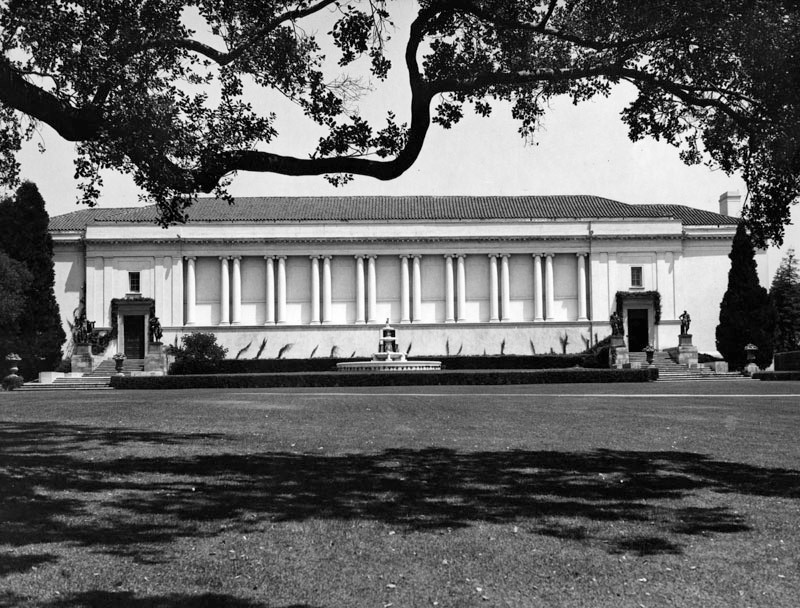 |
|
| (n.d.)* - View of the Library building after the south windows were closed . The four bronze statues at the two entrances to the building are life size and were cast in Italy for Francis I, King of France, early in the XVI century. They are from left to right: the Apollo Belvedere, the Diana of Versailles, Hercules and Telephus, and the Belvedere Mercury. There is also a large fountain in front of the building. |
Historical Notes In the west wing of the Library building is installed the Arabella D. Huntington Memorial Art Collection, consisting of Renaissance paintings and French decorative art of the XVIII century. The Library contains original manuscripts and first and early editions of English and American literary and historical works, and incunabula (or books printed before 1501).* |
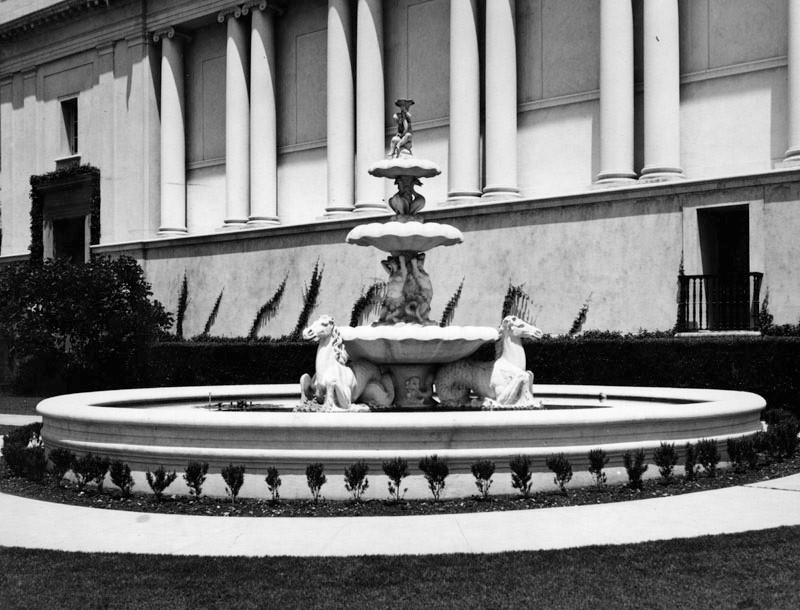 |
|
| (1937)* - Fountain on the terrace in front of the Huntington Library, originally from the Grimaldi Palace, Venice. |
 |
|
| (n.d.)* - View of the North Vista lawn and the statues on one side, at Huntington Library and Art Gallery. |
 |
|
| (n.d.)* - View of a pool of water reflecting the pillars and building along its edges, on the grounds of Huntington Library and Art Gallery. |
* * * * * |
Colorado Boulevard
.jpg) |
|
| (ca. 1920)++# – View looking east on Colorado Boulevard from Raymond Avenue showing a uniformed officer directing traffic from the middle of the intersection. |
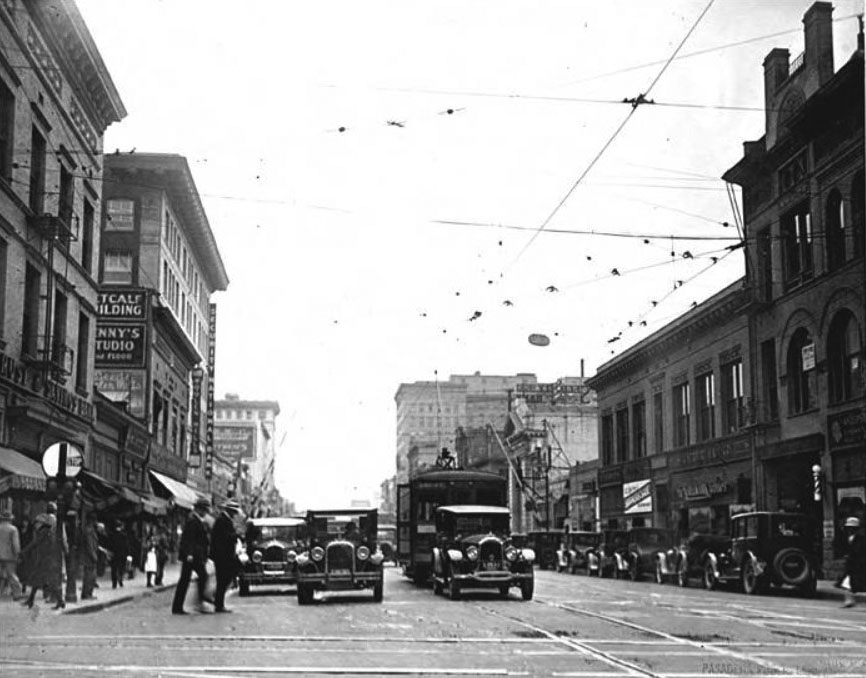 |
|
| (1926)*^* – View looking east on Colorado from Raymond showing several people crossing the street with streetcar and autos waiting at the intersection. Note the overhead streetcar wire above the intersection. |
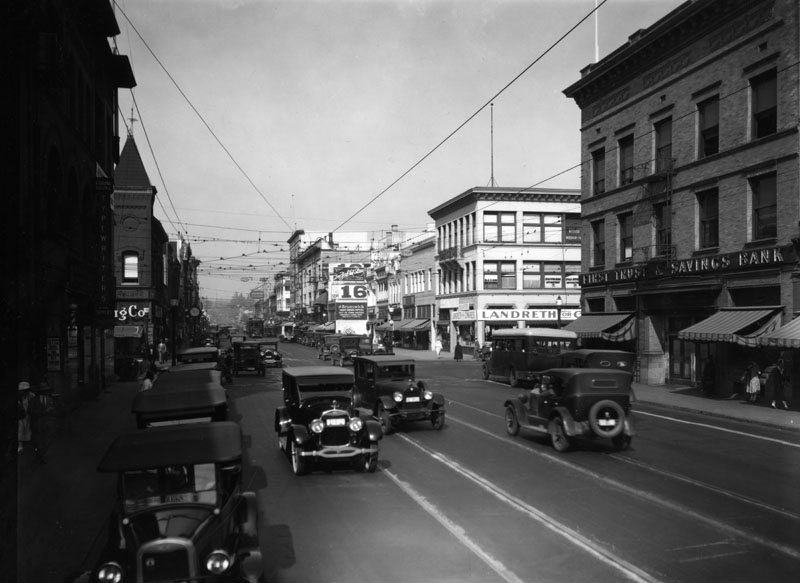 |
|
| (1920s)* - Cars on Colorado Blvd. in Pasadena in 1920. First Trust & Savings Bank is on the right, at Raymond Avenue. |
 |
|
| (1920)s* - Another view of Colorado Boulevard in Pasadena in 1920. A streetcar carries a sign, "Woodbury Road." |
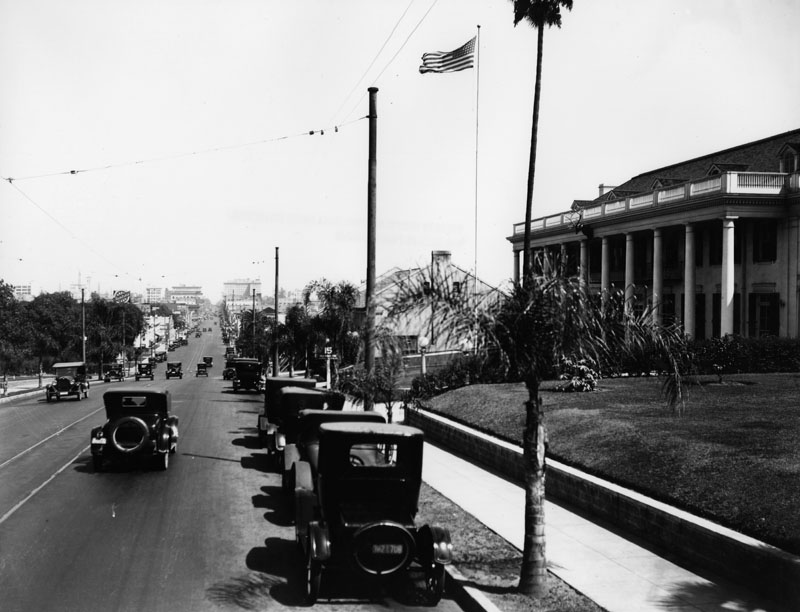 |
|
| (1920)* - Colorado Blvd. in Pasadena looking east on Colorado Blvd. from the Elks Club (on right) in 1920. View is from just east of Orange Grove Ave. |
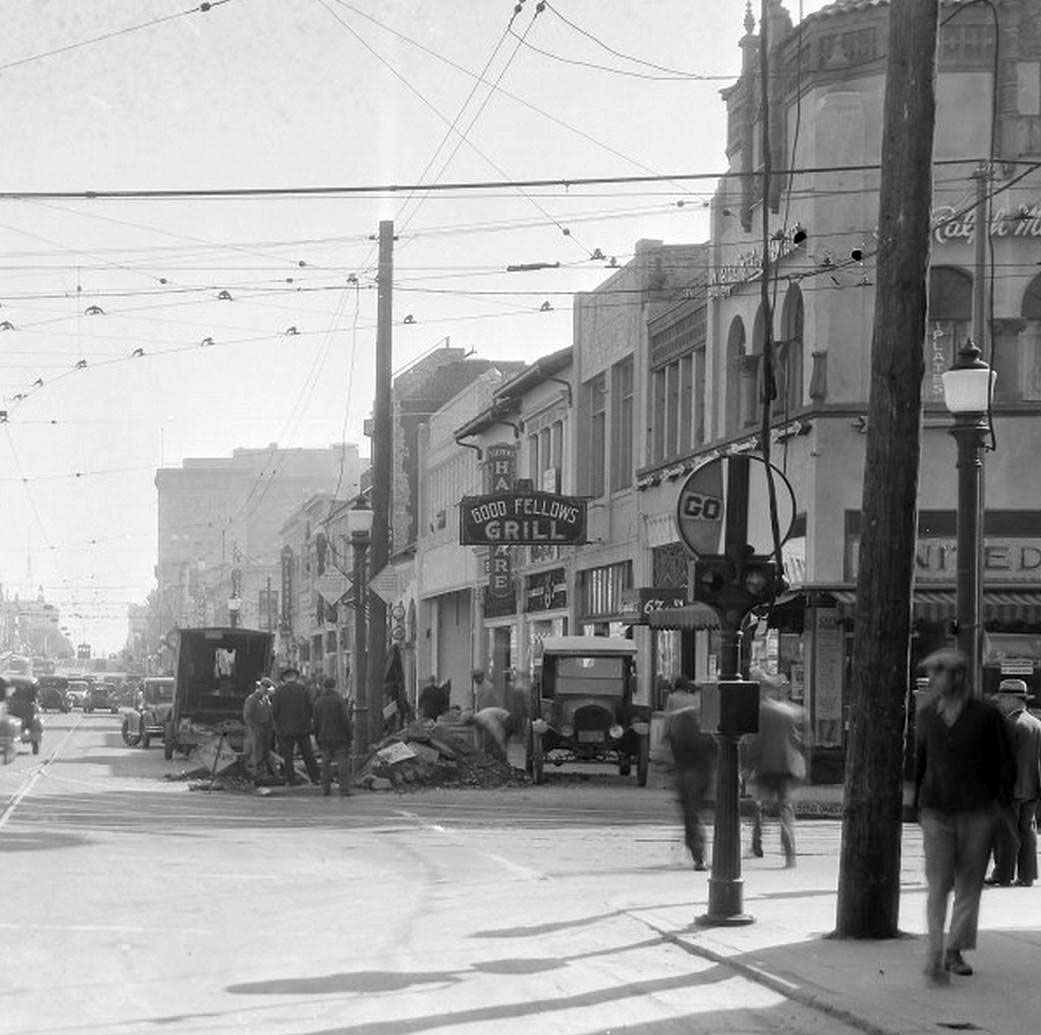 |
|
| (1920s)^*# - Looking east on Colorado Boulevard from Fair Oaks Avenue. Construction workers are digging up the street in front of Good Fellows Grill. |
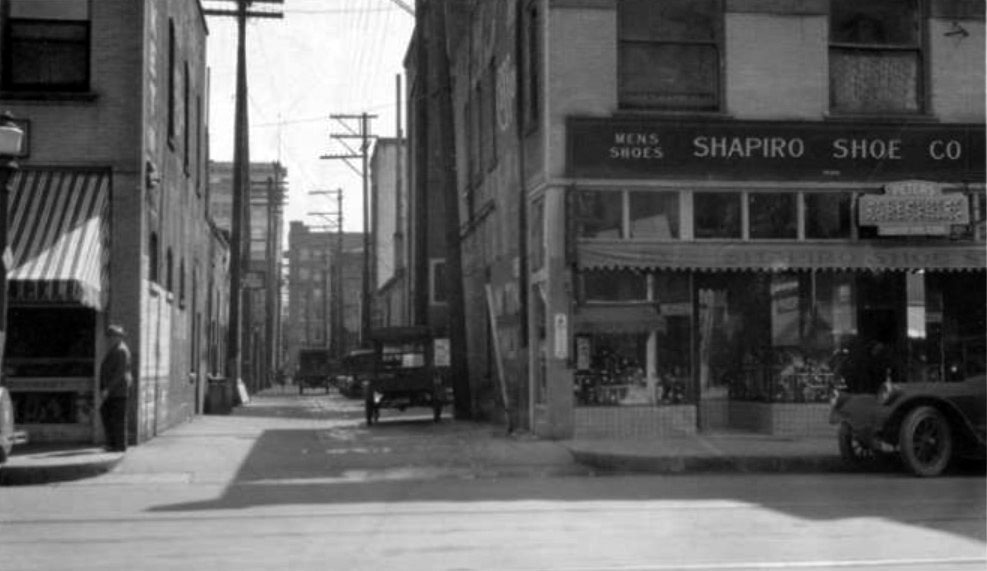 |
|
| (1920s)*^* – View showing the alley between Colorado and Union looking east from Fair Oaks. Shapiro Shoe Store can be seen on the right. |
Mother Goose Pantry
.jpg) |
|
| (1927)* - Mother Goose Pantry, located on the north side of Colorado Blvd. between Berkeley and Greenwood Aves. View is to the west. |
Historical Notes This structure graced Colorado Blvd from ca. 1927 to at least the mid-1940s. |
 |
|
| (1920s)+## - View showing Mother Goose Pantry, located at 1951 East Colorado Boulevard. This was a 'shoe-in' for best design in the 1920s. |
Historical Notes In the 1920s, as the automobile was becoming the default way to get around the Southland, buildings and structures in the area became more unique, often resembling the merchandise or services they hawked. These “hey-you-can’t miss-me!” buildings (referred to as Novelty or Programmatic Architecture) were made to pull automobile drivers right off the road. |
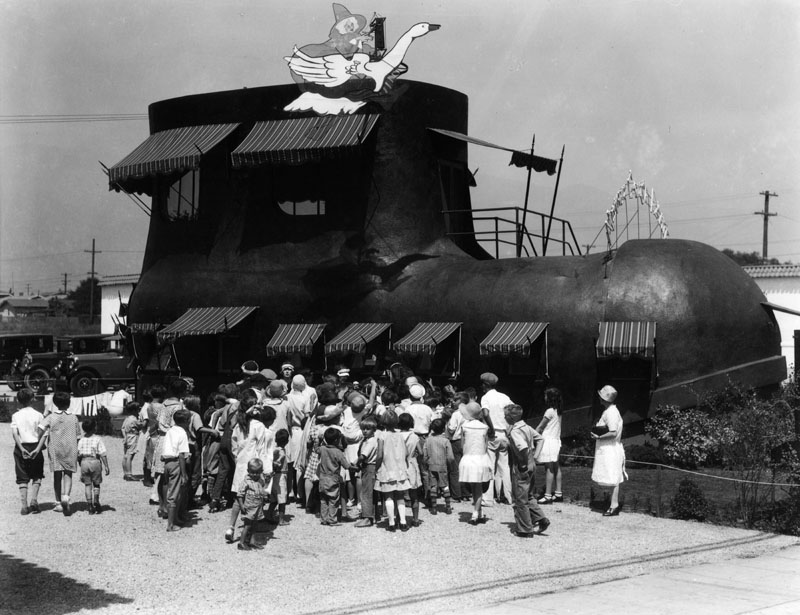 |
|
| (1927)** - The Mother Goose Pantry in an ad in the 1927 cookbook by the Woman's Auxiliary of the Pasadena Fire Department. Source: Pasadena Central Library |
Historical Notes The restaurant served hearty meals from the whimsical shoe that attracted patrons driving along Route 66 from the east coast to Los Angeles. Diners would be seated on the ground floor and in a dining room upstairs. Click HERE to see more examples of Programmatic Architecture. |
Brookside Park
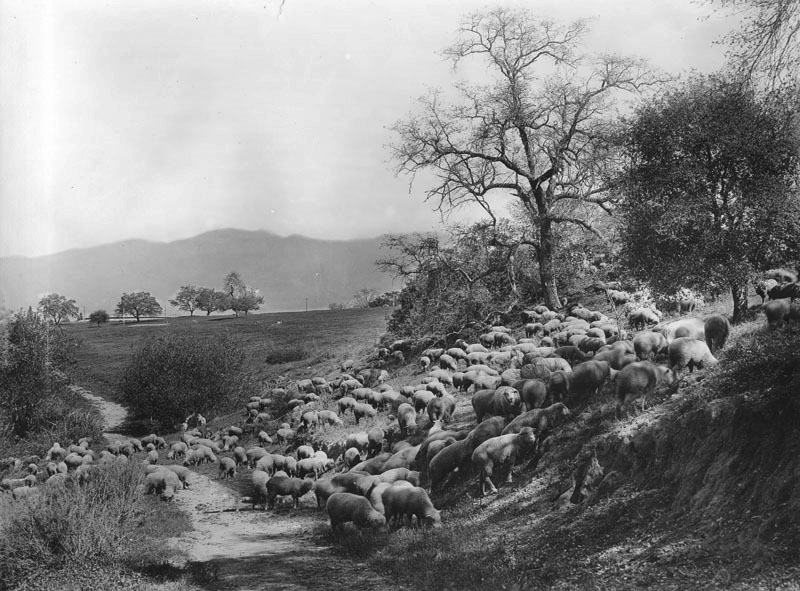 |
|
| (ca. 1906)* – Sheep graze among the oaks in an area near the Arroyo Seco in Pasadena. The San Gabriel Mountains are seen in the background. |
Historical Notes In 1912 the City of Pasadena purchased 30 acres of land known as Sheep Corral Springs for the development of a park in the Arroyo Seco. For many years sheep had grazed in that area. While the park was being planned and constructed, it was known as Arroyo Springs Park.^ |
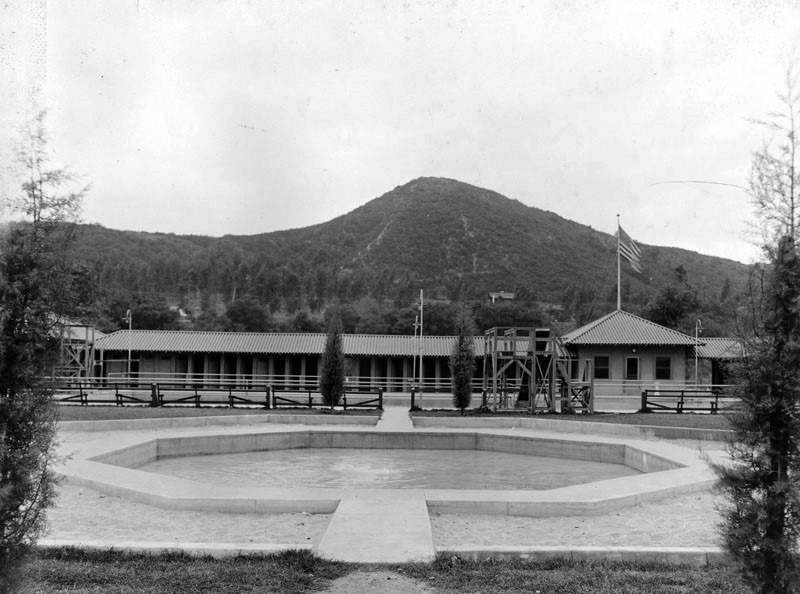 |
|
| (1915)^## - View showing a wading pool and swimming pool with hill in the background in Brookside Park, located at Arroyo Terrace and N. Grand Avenue, Pasadena. The pool area was known as the Brookside Plunge. |
Historical Notes TIn 1914 Mrs. Everett Wellington Brooks, the wife of a local investment banker, donated $3,000 to build a municipal swimming pool on a portion of land within what was then known as Arroyo Springs Park. The park was then dedicated in her honor (hence "Brookside") and the plunge was added later that same year.^ |
 |
|
| (ca. 1920s)^^# - Postcard view showing the Arroyo Seco with swimming pool and wading pool in the foreground, Brookside Park. |
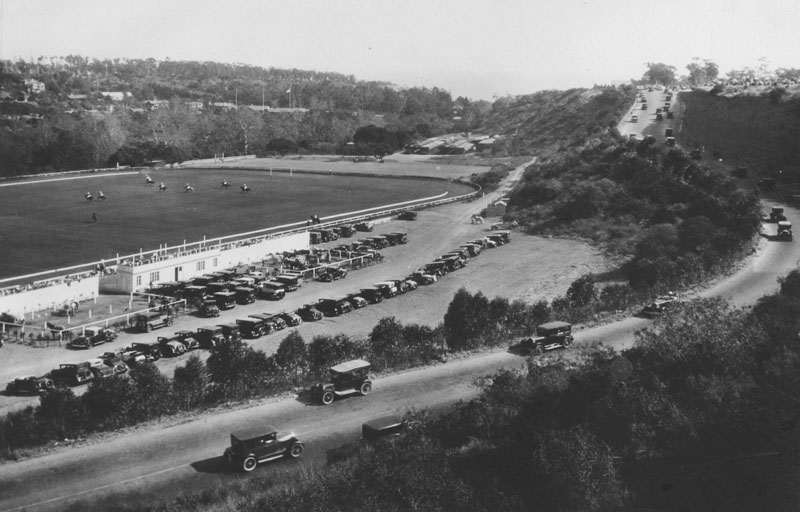 |
|
| (1920)* - View of Pasadena's Brookside Park showing a stream of cars coming down the hill on the right, a parking lot mid-photo, and a large grassy area, possibly an equestrian field, on the left. Several people can be seen riding horses, possibly playing in a polo match, and more horses are visible in penned-in sections between the cars on the parking lot. Homes are nestled in the hills along the background. |
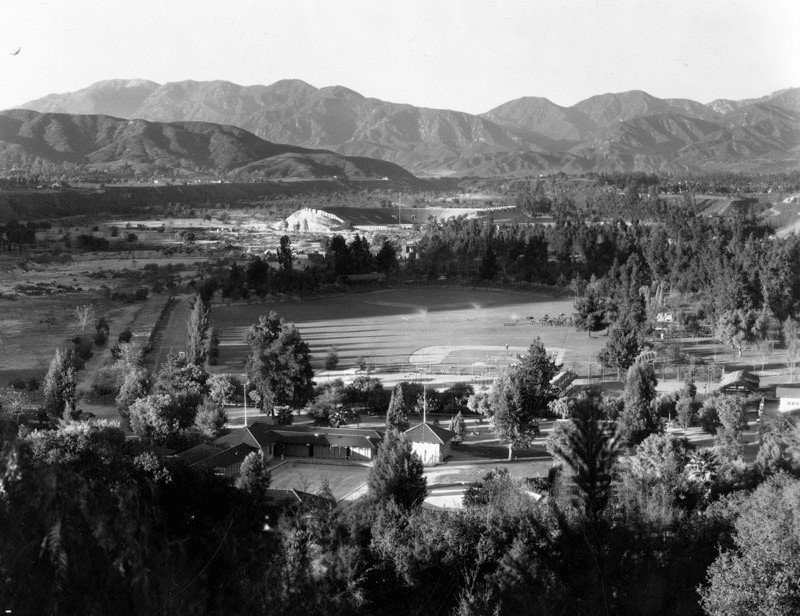 |
|
| (ca. 1925)* - View of the baseball field at Brookside Park in Pasadena. The Rose Bowl, in the shape of a horseshoe, can be seen in the background. The Brookside Plunge is seen in the foreground. |
Historical Notes Originally built as a horseshoe, the Rose Bowl stadium was expanded several times over the years. The southern stands were completed in 1926, making the stadium a complete bowl. The above photo was taken prior to 1926. Today, Brookside Park is Pasadena's largest park covering over 61 acres. It contains the world-famous Rose Bowl Stadium, Brookside Golf Course, and Rose Bowl Aquatics Center, as well as several regulation baseball fields, multi-purpose fields, picnic areas, tennis courts, badminton courts, handball courts, horseshoe courts, archery, casting and lawn bowling facilities, etc., making it Pasadena's largest fully maintained park facility. Brookside Park is located at 360 North Arroyo Boulevard in the city of Pasadena.* |
Baseball at Brookside Park
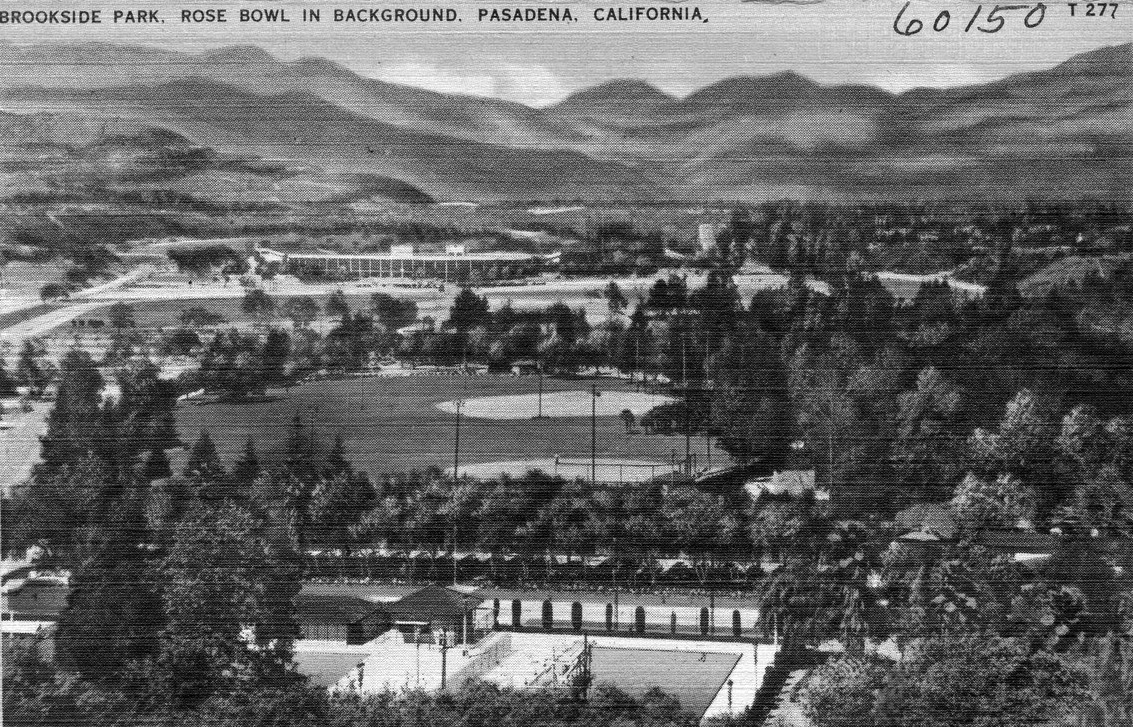 |
|
| (ca. 1930s)##++ – Postcard view showing Brookside Park with the Rose Bowl seen in background. Two baseball fields can be seen at center of photo. |
Historical Notes From 1933 to 1942 and from 1946 to 1950, the Chicago White Sox held their spring training in Brookside Park.^ |
 |
(1938)# - Fans watch from bleachers at Brookside Park as the Chicago White Sox practice during Spring Training. | |
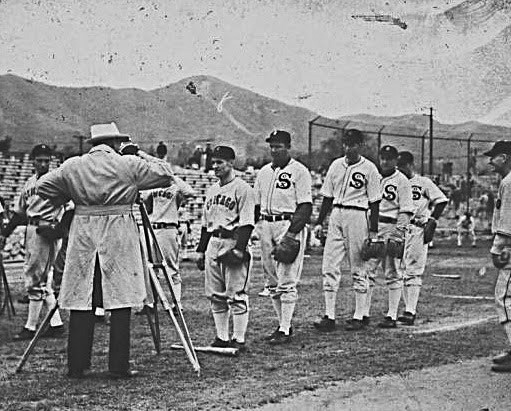 |
(1938)# - Chicago White Sox players line up in front of a movie camera for a newsreel that would be shown in theaters. (Brookside Park, Pasadena) |
|
Brookside Plunge
 |
|
| (ca. 1938)*^* – View showing children at play at the Brookside Plunge in Brookside Park, Pasadena. |
Historical Notes In 1914 Mrs. Everett Wellington Brooks, the wife of a local investment banker, donated $3,000 to build a municipal swimming pool on a portion of a park located in Arroyo Seco. The park was dedicated in her honor (hence "Brookside") and the plunge was added later that same year.^ |
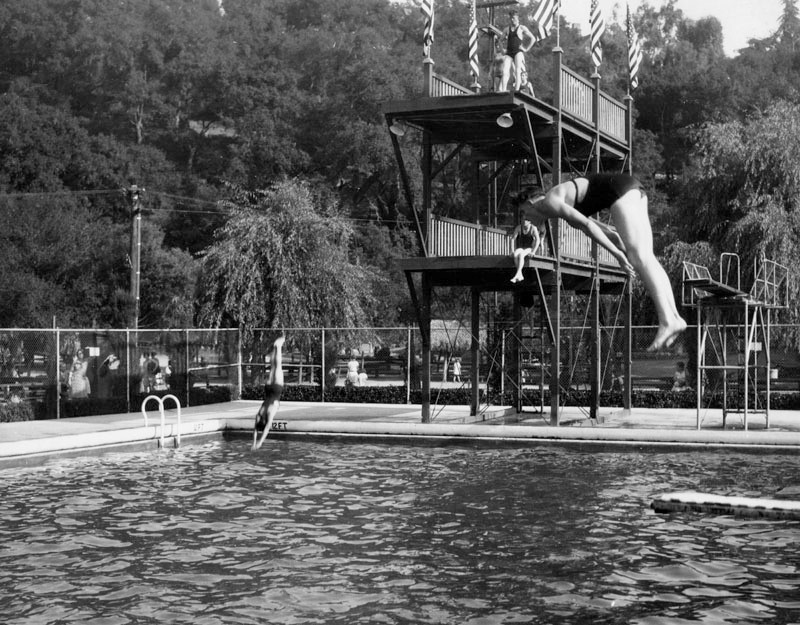 |
|
| (1938)* - Close-up view showing swimming pool and diving platform at the Brookside Plunge in Brookside Park. |
Historical Notes There exists an uncomfortable racial history of the Brookside Plunge. It was a different time in Pasadena and throughout the nation, and segregation was common. Soon after the plunge was completed, city officials announced that it would be "set aside Wednesday afternoons and evenings for the use of the Negro population of Pasadena." By 1930 use of the pool by people of color -- by now including residents of Hispanic and Asian descent -- was limited to one weekday from 2 to 5 p.m. The weekly event was dubbed "International Day." No white people were permitted to swim on that day. The pool was drained and cleaned at the end of each International Day and by the following morning there was fresh water in it. After protracted litigation, the practice was ended in 1947 when the pool was opened to all swimmers in Pasadena, regardless of their race..*^* In 1989 the Rose Bowl Aquatics Center opened on the site, funded with $4.5 million from the City of Pasadena and $2 million in private donations. |
Devil's Gate
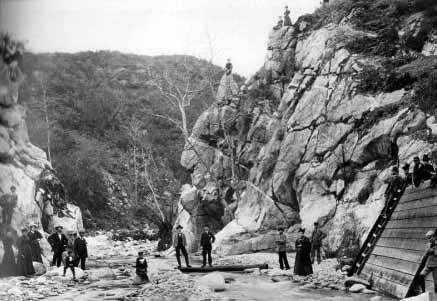 |
(1888)^#^ – Early view of Devil’s Gate showing the Arroyo Seco at its most narrow point. |
Historical Notes The outcropping of rugged granite cliffs offered shade in the morning and late afternoon, make it a favorite community gathering spot. Local residents would pack lunches and have family picnics here. The name Devil’s Gate was given because the profile of a devil’s face can be seen on a cliff at the right. In this photo a man is sitting on top of the devil’s horn.^#^ |
 |
|
| (ca. 1890)++# - Closer view showing a group of people in front of the downstream face of Devil's Gate. Note the ‘advertisements’ written on the rocks. |
.jpg) |
|
| (ca. 1890)++# - View of Devil's Gate from upstream side with the Devil on left. |
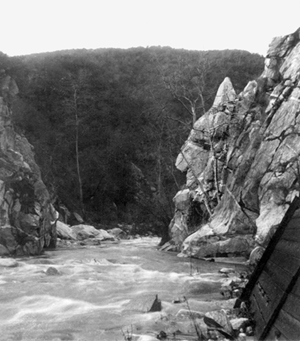 |
(ca. 1910s)*^ - The Devil's Gate at the Arroyo Seco River prior to 1920 damming. Note the "devil's profile" in the rock to the right.
|
Historical Notes Above Devil's Gate, the rapids of the Arroyo Seco are so positioned so that the falls make a beating, laughing sound. In Tongva-Gabrieliño traditional narratives, this is attributed to a wager made between the river and the coyote spirit.*^ |
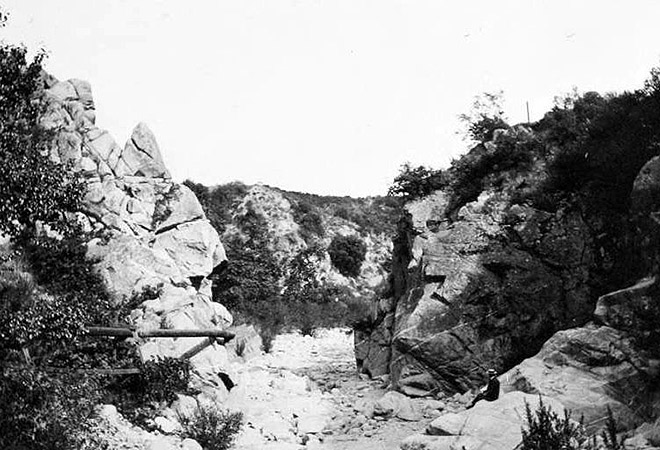 |
|
| (Early 1900s)^ - View of a lone picnicker at Devil’s Gate. The rock face on the left was said to resemble a horned devil. |
Historical Notes In the prehistoric past, Devil’s Gate was not a gate at all but a natural dam, formed where the stalwart granite of the San Rafael Hills merged with the bajada of the San Gabriel Mountains. For a time, this dam held back a natural lake fed by mountain streams. Then one day the dam burst. Spilling over the top, rushing water exploited weaknesses in the granite and punched a narrow gap through the rocks, unleashing a flood wave downstream. The gate—and its peculiarly shaped crag—was born. #^#^ |
 |
|
| (Early 1900s)++# - A man and a woman are seen on the rocks of Devil’s Gate. |
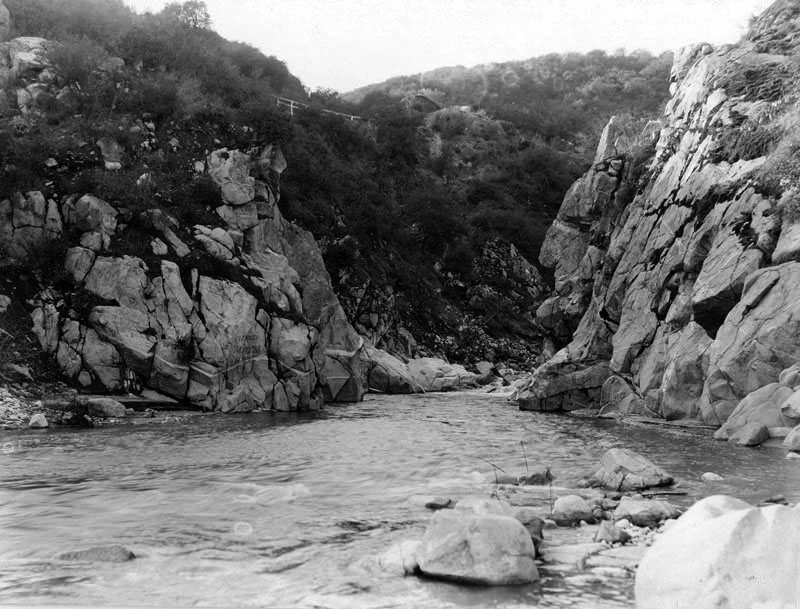 |
|
| (1908)^*# - View of the Devil's Gate with more water flowing than previous photo. A dam would be built across this section of the Arroyo Seco Canyon in 1920. |
Historical Notes Disastrous floods in 1914 and again in 1916 prompted Pasadena and the Los Angeles County Flood Control District to reverse the work of that ancient cataclysm. Between 1919 and 1920, the Los Angeles County Flood Control District erected an arched, concrete dam just upstream from the Devil’s Gate formation. #^#^ |
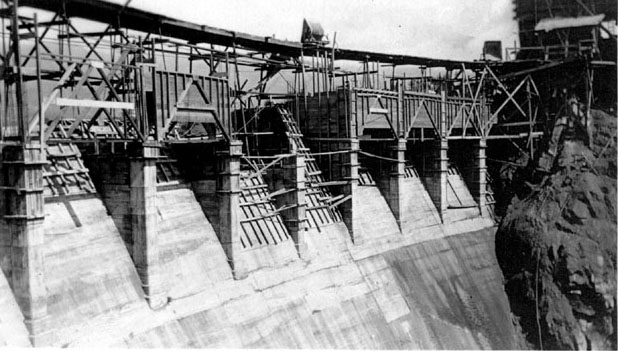 |
|
| (1920)^#* - View of the Devil’s Gate Dam under construction, the first of the Los Angeles County Flood Control District's dams. |
Historical Notes The Devil’s Gate Dam was built in 1920 as part of the Arroyo Seco flood control scheme designed to tame destructive rain-driven flooding as far south as downtown Los Angeles, whose river the Arroyo feeds. Though a dam now reaches across the gorge, the water still laughs as it flows through the sluice gates, and the Devil’s face ominously remains intact.^^^ |
 |
|
| (1920)++# - View of Devil’s Gate Dam shortly after it was completed. |
Historical Notes Devil’s Gate Dame, completed in 1920, was the first of the Los Angeles County Flood Control District's dams. |
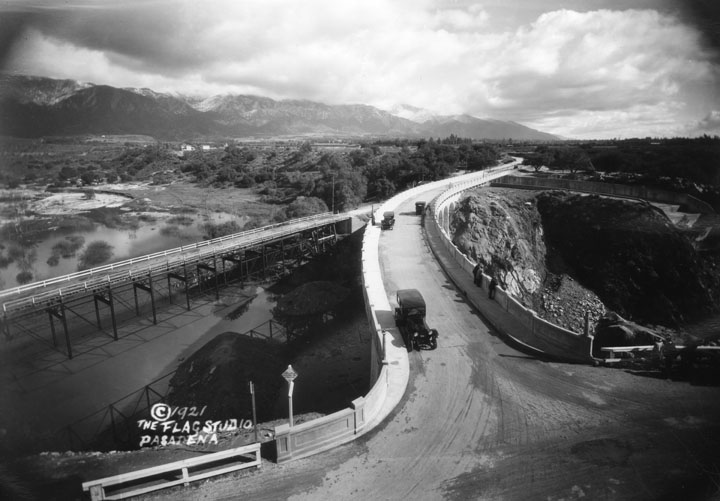 |
|
| (1921)* - A view of the road with 3 people on the edge of the bridge looking down at Devil's Gate Dam. On the left side of the picture is another road, and some water is collected in the area. |
Historical Notes The bridge on the left is the original bridge over the site of the Devil's Gate Dam. As of 1987, there is no longer a reservoir. The site may be seen from Highway 210, north of the Arroyo Seco and south of Jet Propulsion Laboratory. Look up location of Devil's Gate.* |
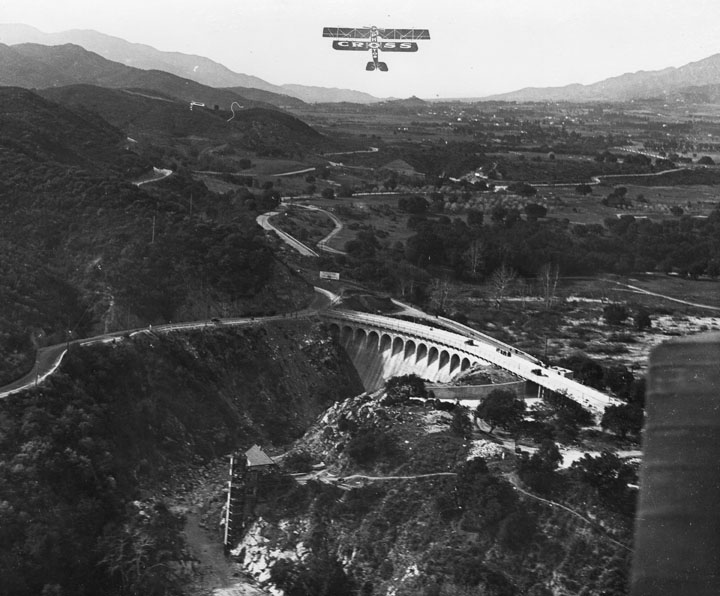 |
|
| (ca. 1920s)* - A view from the air of the Devil's Gate Dam, probably in the 1920's. A few people are visible on top of the dam road, but there does not appear to be any water in the reservoir. |
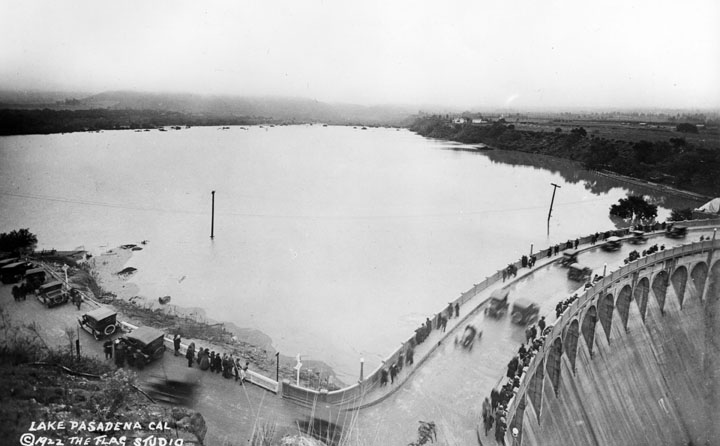 |
|
| (1922)* - A great many people are gathered to look over the road running across the Devil's Gate Dam. Behind the dam is large lake or reservoir. |
Historical Notes Soon after the dam was built it filled with water. The dam was designed for both flood control and water conservation. It also served as the main road between La Canada and Pasadena for many years. |
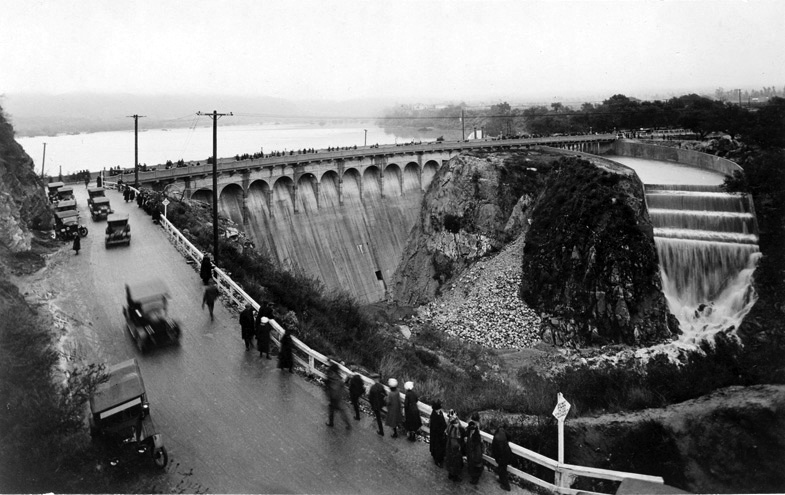 |
|
| (ca. 1920s)^*# - Looking from the adjacent hillside we see the road, the dam and the reservoir behind the dam. Water is rushing down the spillway. |
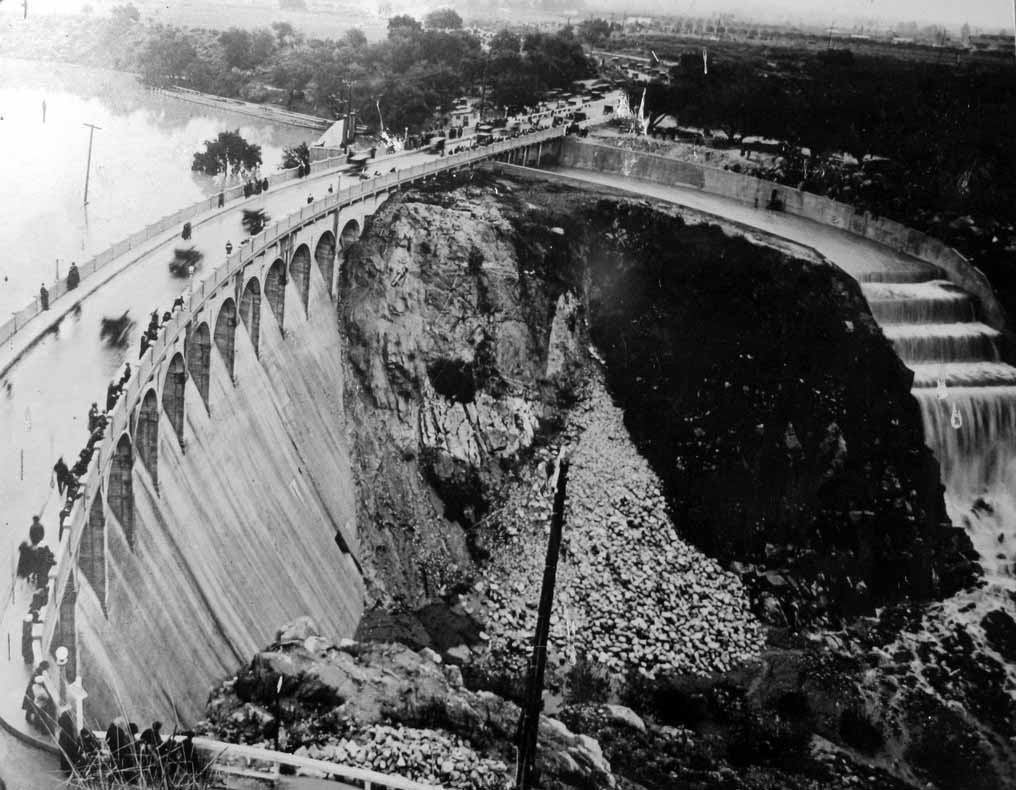 |
|
| (ca. 1920s)^*# - People are standing on top of the Devil's Gate Dam observing water coming down the spillway. |
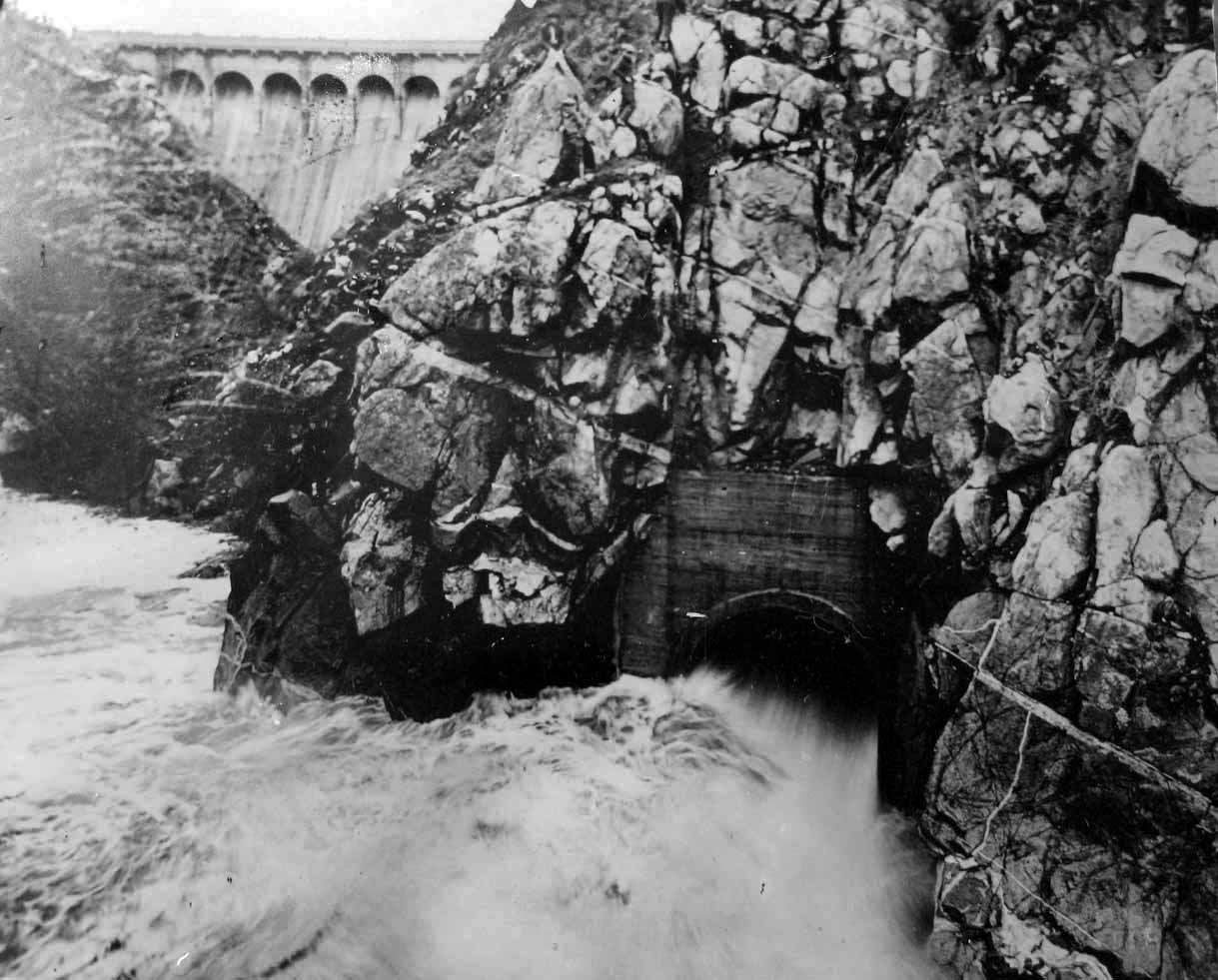 |
|
| (ca. 1920s)^*# - Water is rushing out of a second spilway in the bottom of the canyon. The Devil's Gate Dam is seen in the background. |
Historical Notes The Arroyo Seco watershed begins at Red Box Saddle in the Angeles National Forest near Mount Wilson in the San Gabriel Mountains. As it enters the urbanized area of the watershed, the Arroyo Seco stream flows between La Cañada Flintridge on the west and Altadena on the east. Just below Devil's Gate Dam, the stream passes underneath the Foothill Freeway. At the north end of Brookside Golf Course the stream becomes channelized into a flood control channel and proceeds southward through the golf course.*^ |
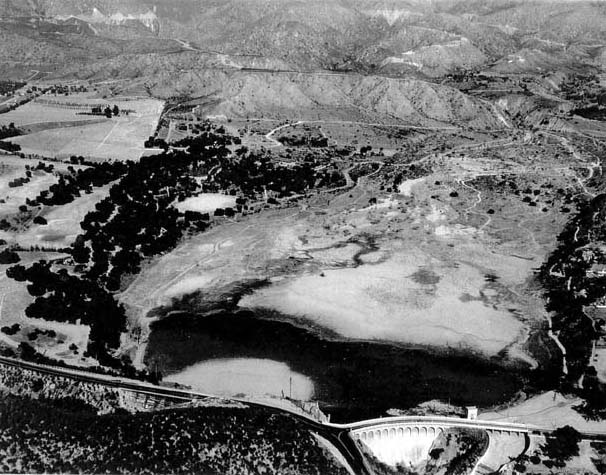 |
|
| (1935)^#* - An aerial view, taken December 18, 1935, shows water flowing into the Devil's Gate Dam basin from La Canada through Flynt Canyon Wash in the lower left. The dense oak grove with the clearing in the middle is also clearly depicted. |
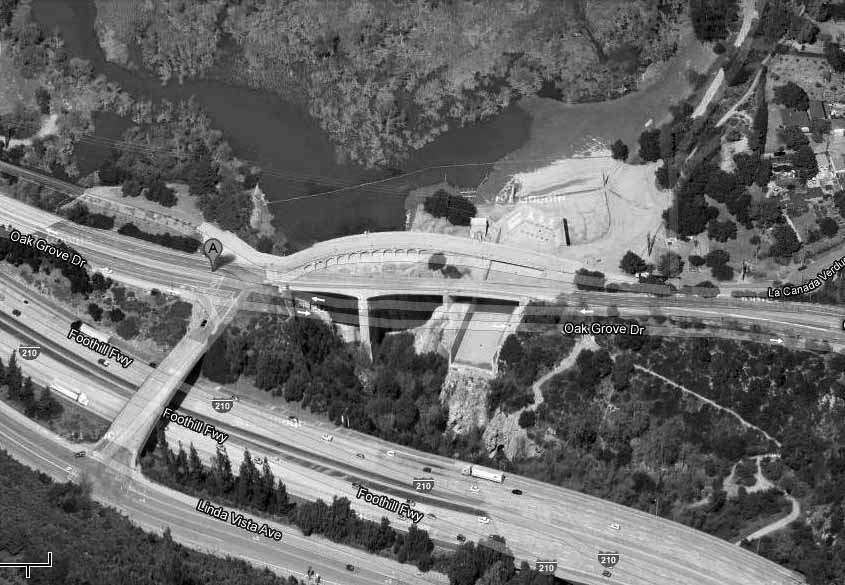 |
|
| (2013)## - Google Maps view of Devil's Gate Dam showing the 210 Freeway in the foreground. |
* * * * * |
Raymond Theatre
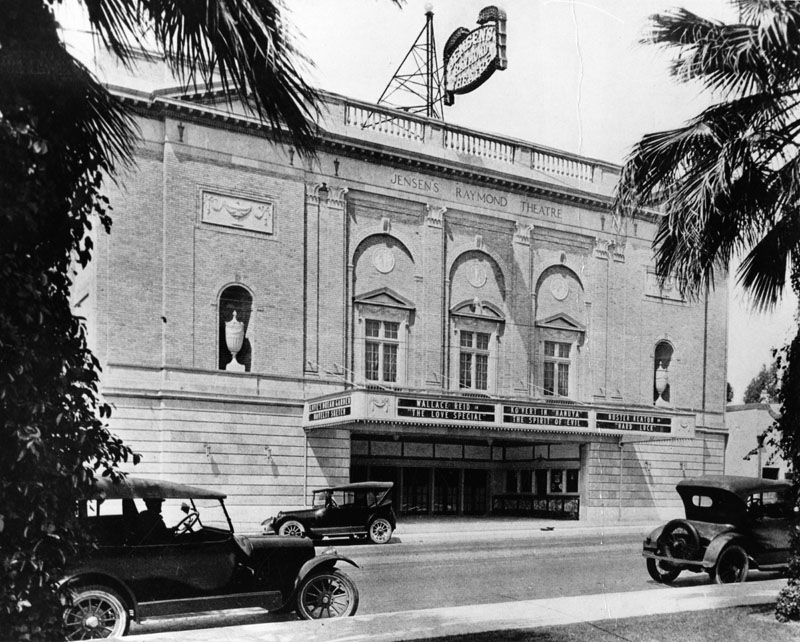 |
|
| (1922)* - Exterior front of the Raymond Theatre, with cards parked in the street. Marquee reads: "Wallace Reid in The Love Special ; Ko'vert in Hanuya The Spirit of Evil ; Buster Keaton in Hard Luck". |
Historical Notes There was a great deal of anticipation leading up to the opening of Jensen’s Raymond Theatre on April 5, 1921. But there was also a sense of amazement in the cost of the construction. The Star News, on May 6, 1920, reported that the project was over budget, with a cost to date of $592,644. When it opened, all was forgotten, and the Pasadena Star-News exclaimed the Raymond to be “Last Word in Modern Thespian Temples". *^^* |
* * * * * |
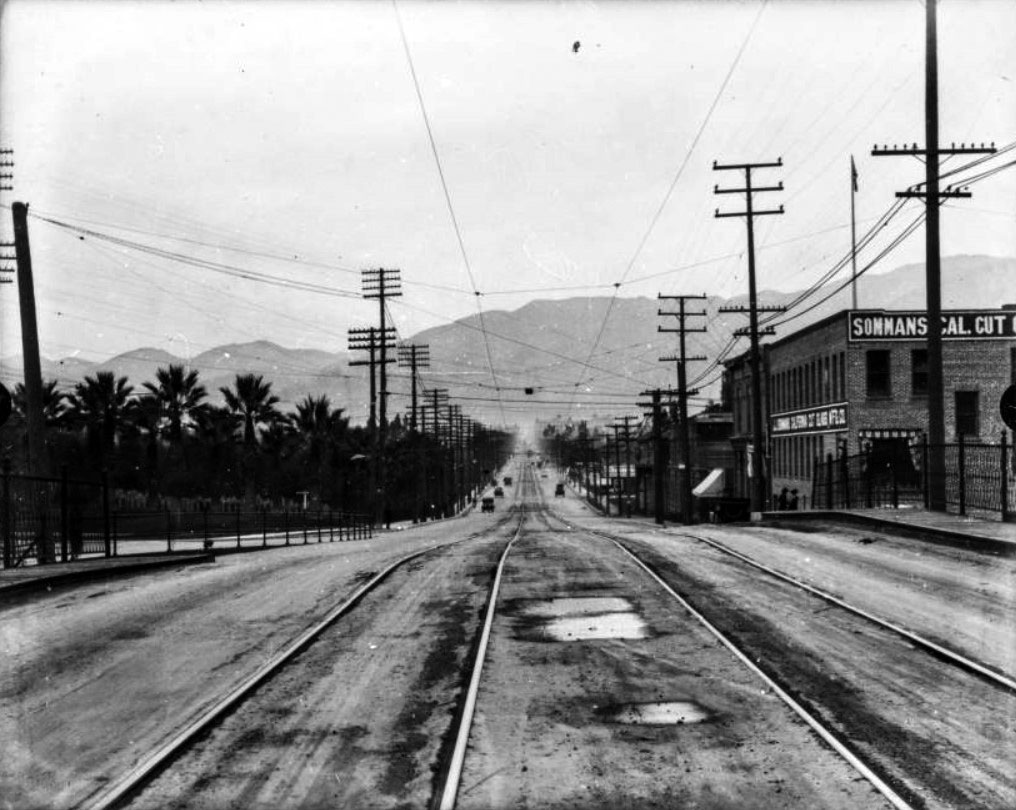 |
|
| (ca. 1920s)#* – View looking north on Fair Oaks Avenue in Pasadena towards Glenarm Street with the San Gabriel Mountains in the background. On the right is Somman’s California Cut Glass Mfg. Co. located at 1172-1186 S. Fair Oaks Avenue. |
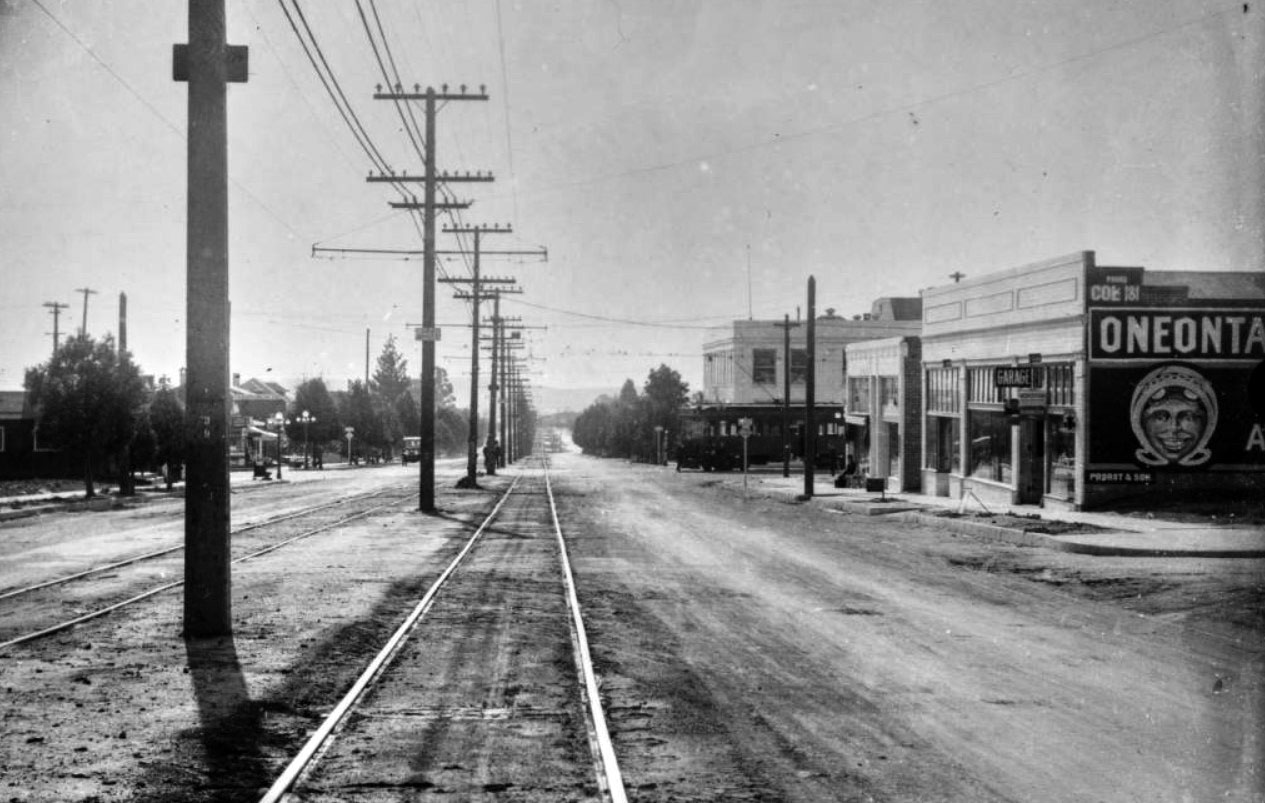 |
|
| (ca. 1920s)#* - Pacific Electric Railway tracks on a street in what appears to be South Pasadena. A sign on the center pole says "Hope St." which is a street in South Pasadena. A storefront says "Fagg-Dublin Co." which was a business in South Pasadena. A huge advertisement is on a wall that reads "Oneonta." |
Mission Street (South Pasadena)
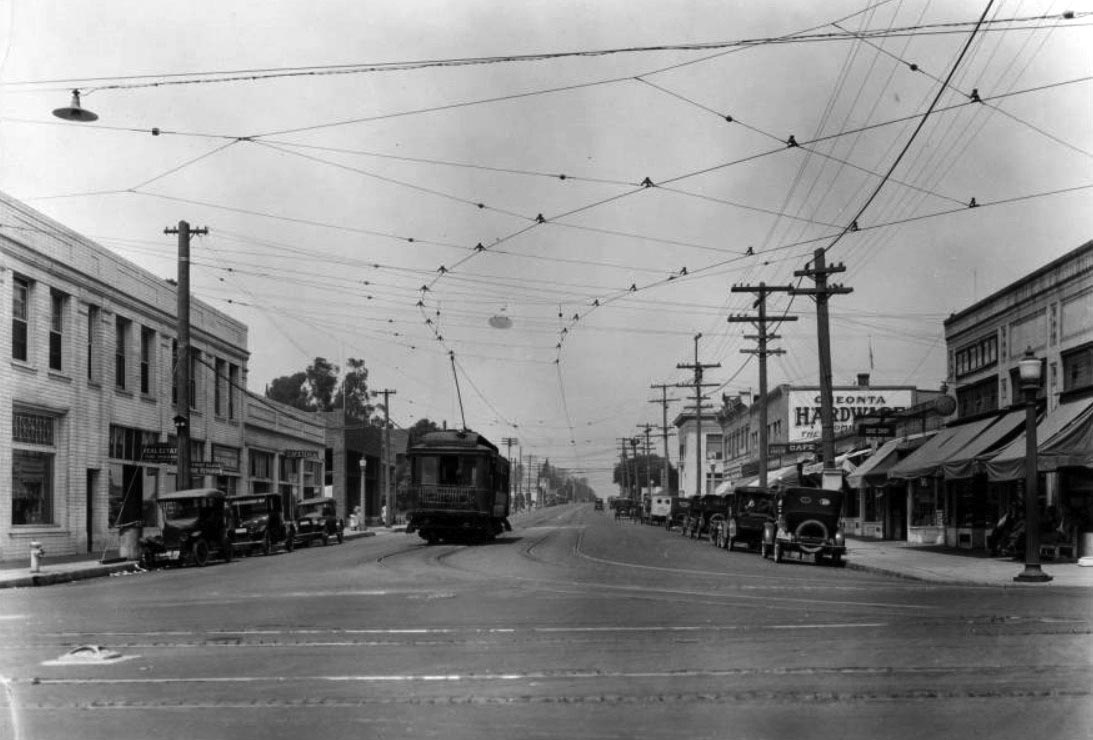 |
|
| (1922)#* - View of Mission Street in South Pasadena, showing a streetcar that says "South Pasadena" across the top, storefronts of businesses and automobiles parked on street. A wall on right says "Oneonta Hardware." |
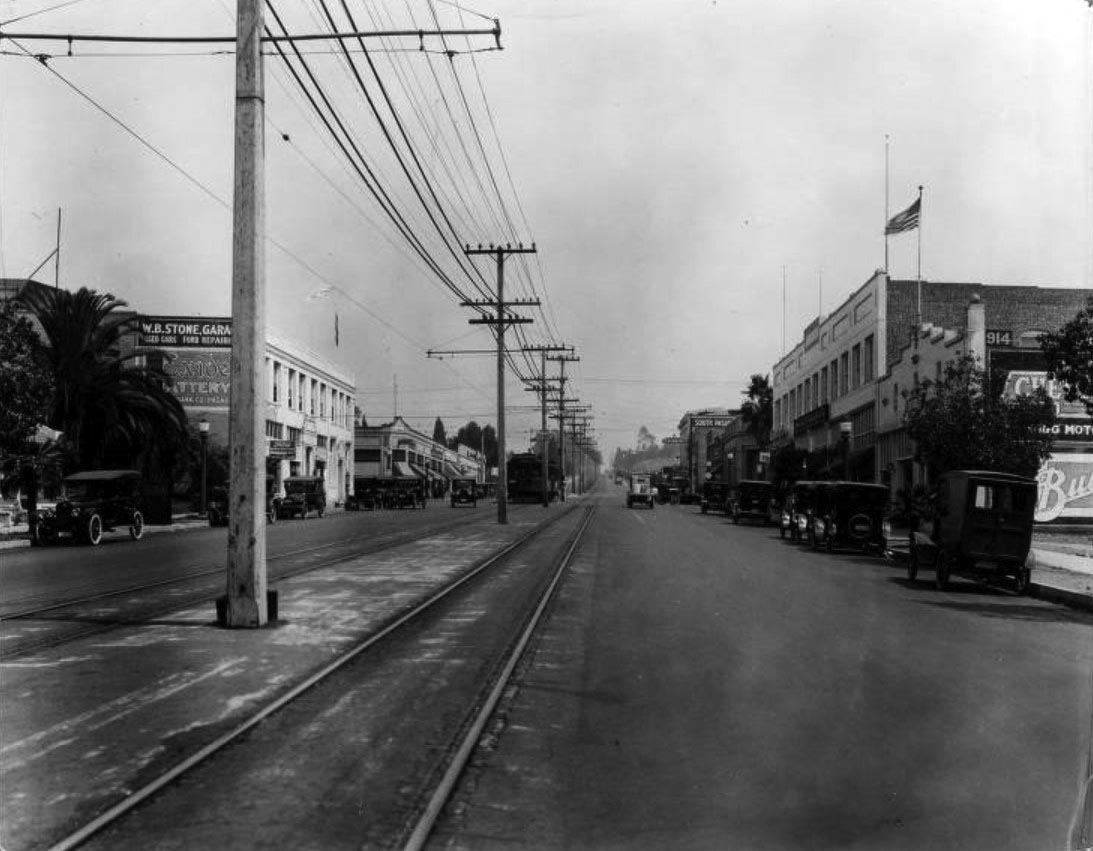 |
|
| (1922)#* - View of Mission Street in South Pasadena, showing streetcar tracks, storefronts of businesses and automobiles parked on street. A small sign on center pole says "Mission Street." Signs on buildings say "South Pasadena" "W.B. Stone Garage" "Sam Seelig Co." and automobile dealerships appear on either side of street. |
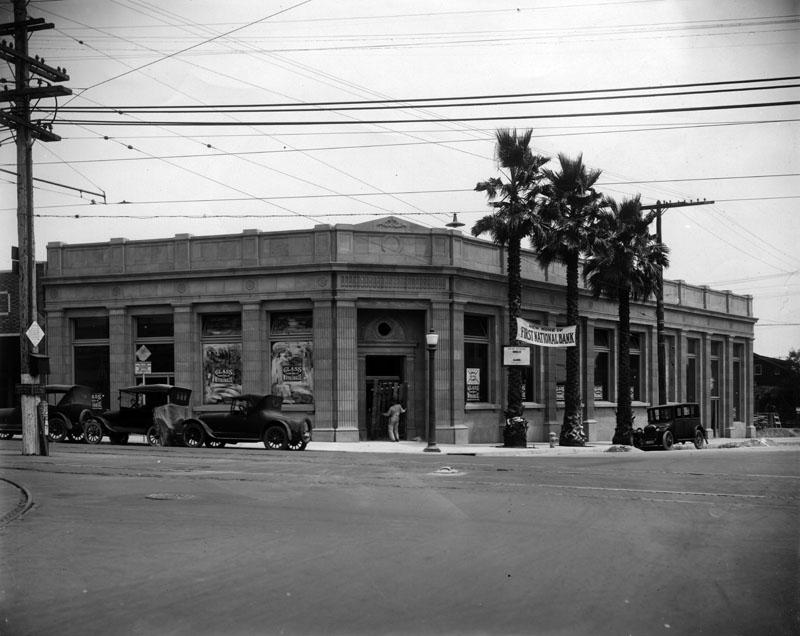 |
|
| (1922)* - Exterior view of a bank, located at 824 Fair Oaks Boulevard on the northeast corner with Mission Street in South Pasadena. At the time this photograph was taken, First National Bank was located in the building, but Security First National Bank also occupied this building. |
Historical Notes This Beaux Arts style building, originally occupied by Security National Bank and today by Comerica Bank, was constructed in 1922 by an unknown architect. The building sits at the confluence of two early alignments of Route 66, and along two Pacific Electric Red Car lines that shuttled commuters and shoppers between Los Angeles, South Pasadena and Pasadena during the bank's heyday.* |
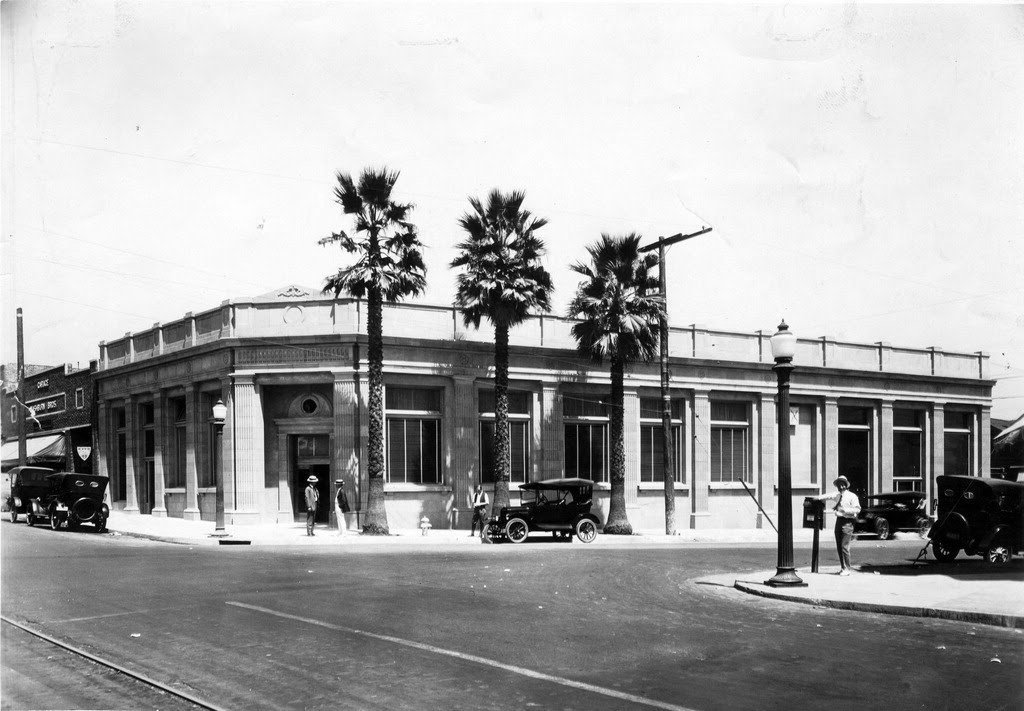 |
|
| (1922)* – Another view of the SE corner of Fair Oaks Boulevard and Mission Street. This building would be home to several banks and a furniture store over the years. It is the current home of Comerica Bank. |
Historical Notes This Beaux Arts style building was “remodeled” during 50s, then restored in 2000s. |
Then and Now
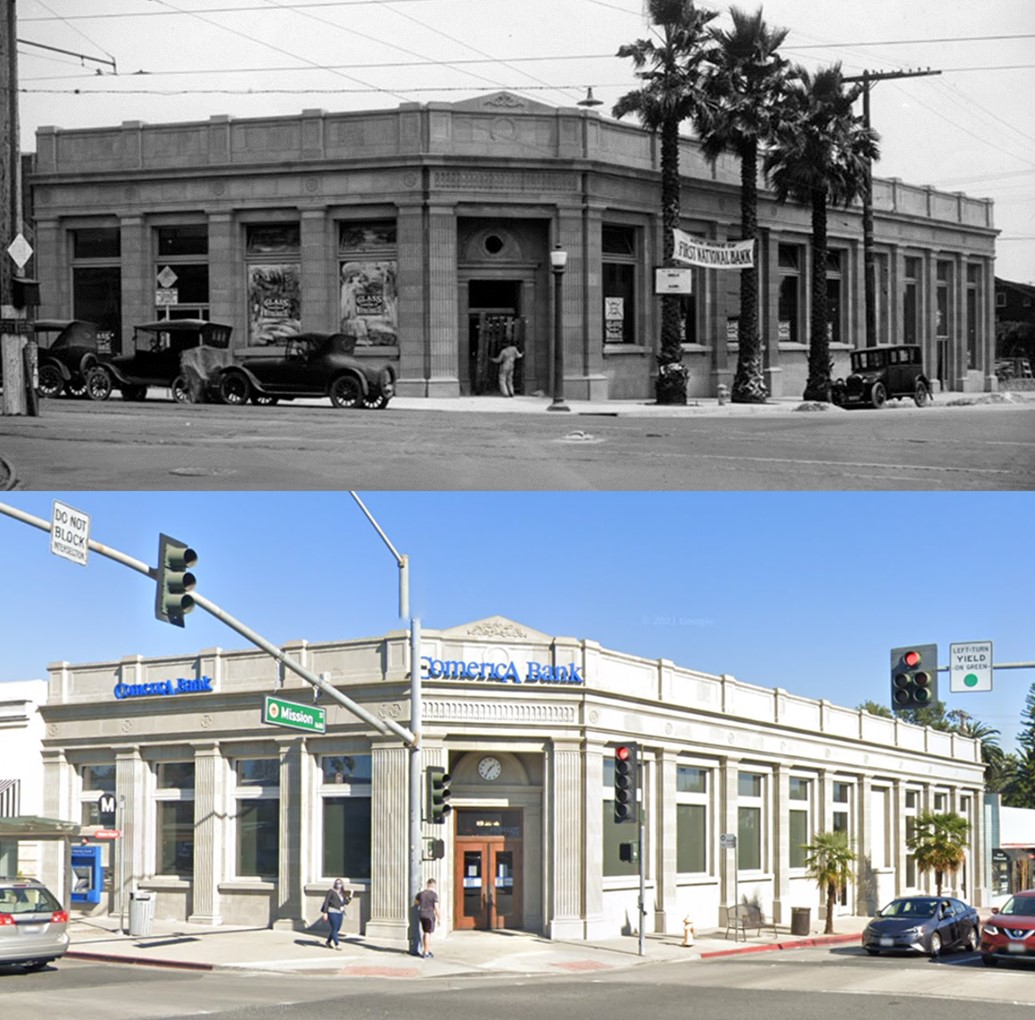 |
|
| (1922 vs. 2021)* - Looking at the northeast corner of Fair Oaks Boulevard and Mission Street in South Pasadena. This Beaux Arts style building, originally occupied by Security National Bank is todauy occupied by Comerica Bank |
* * * * * |
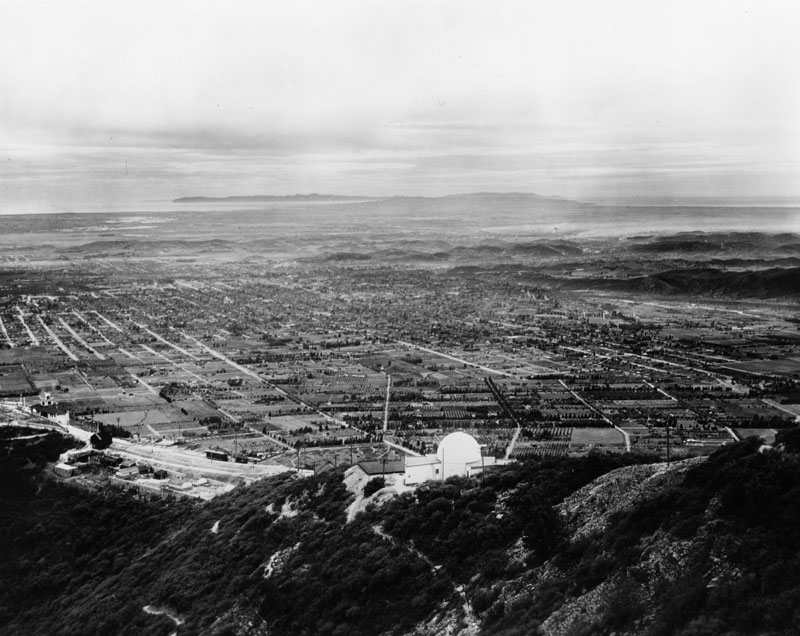 |
|
| (1922)* - Panoramic view of Pasadena and surrounding areas, as seen from top of Echo Mountain. View also shows, Mount Lowe Observatory in the foreground. Catalina Island (over 60 miles away) can be seen in the far background. Click HERE to see more in Early Views of Catalina. |
Click HERE to see more Early Views of Echo Mountain, Mt. Lowe, and the Mt Lowe Observatory. |
* * * * * |
Please Support Our CauseWater and Power Associates, Inc. is a non-profit, public service organization dedicated to preserving historical records and photos. Your generosity allows us to continue to disseminate knowledge of the rich and diverse multicultural history of the greater Los Angeles area; to serve as a resource of historical information; and to assist in the preservation of the city's historic records.
|
More Historical Early Views
Newest Additions
Early LA Buildings and City Views
History of Water and Electricity in Los Angeles
* * * * * |
References and Credits
* LA Public Library Image Archive
^*California Historic Landmark Listing (Los Angeles)
^^UC Irvine - The White City by Miles Clement
*# The Shakespeare Club of Pasadena
+# Examiner.com - Rose Parade no-nos: Sundays, rain, Supreme Court Justices
#* Huntington Digital Library Archive
## Google Maps
*^#CSUN Oviatt Library Digital Archives
**^Colorado Street Bridge nps.com
*^^Nuestra Señora la Reina de los Ángeles: losangelespast.com
^^*LA Times Framework: 1918 Rose Parade; In 1949, the Snowman Socked LA
^*#Noirish Los Angeles - forum.skyscraperpage.com; Devil's Gate; Colorado St. Bridge; Maryland Hotel
^##California State Library Image Archive
+##Weird California: Los Angeles' Programmatic Architecture
###Library of Congress: Hotel Green Panoramic, ca. 1908
**#Metro Transportation Library and Archive
#**Palomar Observatory - Caltech.edu
*#*KCET: Scoville Bridge; Rise of the Sierra Madre
^#^LAghostpatrol.com: Devil's Gate
^.^Facebook: SoCal Historic Architecture
^#*ArroyoSeco.org: Devil's Gate
^^^Atlasobscura.com: Devil's Gate
*^*^Earlyaviators.com: Roy Knabenshue
^*^*Mtwilson.edu: Mount Wilson Observatory
^*^#Facebook.com - Bizarre Los Angeles
*^^*Pasadena: A Busines History
*^^^San Fernando Valley Historic Society/Facebook.com: Wagon Trip
^^*#Facebook.com - Pasadena Digital History
*#*^Denver Public Library Image Archive
*#*#Downtown Pasadena's Early Architecture
^#^^Calisphere: University of California Image Archive
#*#*OldRadio.com; The Story of Mt. Wilson
#^#^Los Angeles Magazine: The Dammed Past of Devil's Gate
##^^Flickr.com: Michael Ryerson
##^*Los Angeles Daily News: Castle Green
##**Electric Railway Historical Association; Pacific Electric
^^^^*Bureau of Street Lighting Image Archive
*^ Wikipedia: History of Pasadena; Tournament of Roses Parade; The Langham Huntington; Hotel Green; Rose Bowl Game; Pasadena City Hall; Old Town Pasadena; Los Angeles Terminal Railway; Richard H. Chambers United States Court of Appeals and the Vista del Arroyo Hotel and Bungalows; California Institute of Technology; Mt. Lowe Railway; Cawston Ostrich Farm; Pacific Electric Railway; Arroyo Seco - Devil's Gate; Mt. Wilson Toll Road; Mt. Wilson; Merritt Mansion; Raymond Hotel; California Cycleway
< Back
Menu
- Home
- Mission
- Museum
- Major Efforts
- Recent Newsletters
- Historical Op Ed Pieces
- Board Officers and Directors
- Mulholland/McCarthy Service Awards
- Positions on Owens Valley and the City of Los Angeles Issues
- Legislative Positions on
Water Issues
- Legislative Positions on
Energy Issues
- Membership
- Contact Us
- Search Index